Flutes and both violins in first part, low strings and high clarinet Sfz in the second.
Modular synthesizer enthusiast with physical disability hacks his arm prosthesis to control synthesizers with his mind:
This is so awesome:
11 second cue: Joyous and triumphant. Measured string tremolos, french horns, trumpet, hard mallet timpani, triangle tremolo:
Got invited by Jonas Wikstrand to do a co-demonstration/presentation on film composing at Thinkery21 tomorrow night. Lots of production peeps will be doing demos. See you there?
24 second epic drum cue sketch: WARNING! THIS IS LOUD! Taiko drums, toms, chinese tam tam, french horn ensemble, tremolo strings:
I published an article on this blog not too long ago about emotional impact in film scoring.
To me, we composers use sample libraries to create music that sounds like an orchestra without hiring one out. This has benefits and also some intense drawbacks. In my view: Sample libraries are great tools if we use them right.
From the article:
Emotional impact upon the audience of any film comes from humans who are primed and encouraged to bring their own emotions to the table, who deliver their own emotions in their performances, who take part in a story that has real impact upon the lives of the viewer.
Can this idea apply to the music of a film?
Oh my my, oh hell yes.
The technology for creating entire symphonies in a bedroom is available. It’s even cheap to produce a recording! To create a massive-sounding orchestral film score, many film composers nowadays rely upon sample libraries that include tens of thousands of individual sounds of instruments in the orchestra. The trade off is that they also have to program and then manipulate all of these samples so that they can create the score. In other words, the samples don’t come prearranged for the composer. The composer has to reprogram the sample library to sound appropriate for the film.
This small, almost insignificant detail, the fact that composers have to rearrange a sample so that it can be appropriate for a film score, has a remarkably stark effect on the emotional impact of a film.
Stay with me on this.
Before I get into why, we need to jump into a favorite subject of musicians and the online forums they frequent: Sample libraries...
Pizzicato strings, french horns, flutes, and celeste
The timpani as a melodic instrument, orchestral chimes, offstage flutes and clarinets, and senza vibrato violas. Dark and menacing!
Composed by Dave Wirth, Copyright and Published 2020 Fire, Fire, Red Star Down! ASCAP. All Rights Reserved.
Sudoku:
Gradus Ad Parnassum (counterpoint):
Reading Notes
27 Minute Read | Laptop or Tablet Recommended
Topics and Themes
Perspective in film music, Narrative and documentary filmmaking perspectives, Size and scale of film scores, Choosing the best audio perspective for a film
The Perspective of the Universe
Our universe is huge.
Okay, that’s an understatement. It’s ridiculously large.
Ummmm, still an understatement. How about this: Our universe is an absolute gargantuan behemoth.
Nope. Still, an understatement. Seriously.
To get a sense of the size of the universe, let me start with how large the Earth is. If we ran a tape measure all around the earth at the equator, we’d have about 7,926 miles. That’s one long tape measure.
Now, let’s talk about the distance between the sun and the earth: 92.96 million miles. This distance is called an Astronomical Unit or AU for short. To make that distance relatable, it would take us 3,333 years to travel the length of one AU if we got in a car and set the cruise control at 80 miles per hour.
Okay, cool. Size of the Earth? Got it. Distance from sun to Earth? Yup, pretty long. What about the size of our solar system?
We can guesstimate that the size of our solar system, aka the distance from the sun to the Oort Cloud which is the furthest reaching mass currently orbiting the sun, is somewhere around 100,000 astronomical units. How many miles is that? 92.96 million times 100,000. Get out the pocket pen protector and the solar powered calculator, or just trust me that it’s a long distance.
Now, let’s talk about the size of our own Milky Way galaxy. In astronomical units, the Milky Way has a girth of somewhere in the ballpark of 6,320,400,000 AU’s. To make that number relatable, it might be easier to frame it in terms of the speed of light. If a single particle of light traveling at 670,616,629 miles per hour wished to travel from one side of the Milky Way to the other, it would take it a cool 100,000 years. Yup. Way bigger.
Let’s kick this up a notch, a big notch:
It was recently estimated that there are 2 trillion galaxies in the universe. 2,000,000,000,000 galaxies. All of varying size. Some small. Some so massive that many multiples of our fair Milky Way galaxy could fit in them. And to top that, galaxies aren’t exactly right next to each other. There’s space out there, man.
Let’s go crazy, now: We have an estimated two trillion galaxies in our universe, all of varying size. There’s room enough for all of them without them being right up in each other’s business. So, how long would it take a single particle of light to travel through each of the two trillion galaxies in succession?
And, so… um…. our universe is not just big:
It’s an embarrassment of abundance.
Now that you have a sense for how large our universe actually is, I can’t help but wonder if you are looking at your life with a bit more perspective. Perhaps you’re contemplating why you put up with your annoyingly outspoken uncle on Facebook?
It’s my firm belief that seriously pondering the size of the universe forces us to look closely at the things in our lives that no longer serve us.
When I was writing the first part of this article, I looked at the room I was sitting in and thought, “Damn, this feels tiny.” It had me scratching my head at the parts of my life that I consider small and petty, and it made me wonder why I even tolerate them. It made me want to change, and that’s the best reason to think about the size and the scale of the universe.
I believe it’s a common truth that we all want to grow and become more of ourselves throughout our lives. We want to become better people, and to do that requires embracing change. Sometimes that change needs to be radically large, and sometimes it needs to be incredibly small. But more often than not, change is most effortlessly made by deeply considering a new perspective.
After all, new perspectives have the effect of shocking and teasing us to think differently. Then, we can jump directly into the flow of change with less friction.
Perspectives Enlarge and Invigorate Us
The act of considering a different perspective expands us. It makes us think outside of ourselves, outside of our normal day-to-day problems. Busywork suddenly becomes less compelling when we have a larger perspective.
Considering the limited amount of time we have on this Earth, we ought to be incredibly careful with the way we live. The narratives we wrap ourselves in can consume us to the point where we don’t even imagine there’s a different way to live. That’s the moment when getting a fresh perspective has the potential to change everything. What was once stuck now becomes dislodged.
New perspectives jolt us in a great way. They push us outside of our comfort zones. They make us consider what we are doing on a daily basis. They give us a chance to grow larger, to expand, to become wiser. They force us to question who we are and what we are doing with the very limited amount of time we have. They offer us the chance to reveal the stories we tell ourselves.
Fresh perspectives help us become (surprise, surprise) better people.
Mark Twain knew the importance of gaining different perspectives. He thought it made a better, more decent human being. A traveler the world over, he wrote:
Travel is fatal to prejudice, bigotry, and narrow-mindedness, and many of our people need it sorely on these accounts. Broad, wholesome, charitable views of men and things cannot be acquired by vegetating in one little corner of the earth all one’s lifetime.
We are never done learning about ourselves, unless we are dead of course. To spend a life insulating ones self from any sort of change is a tragedy. By staying right in our comfort zone, by never venturing outside of what is easy and simple, we can’t possibly learn whether we are living inline with our core values.
And it’s a terrible thing to live our lives in a way that makes us feel extremely unhappy.
The Fear of Living The Wrong Story
Does it frighten you to think that you might be living a life that doesn’t really work for you?
It frightens me sometimes.
We could be living our lives in a way that is completely disingenuous to our values. We might be ignoring what we really care about.
You might care about your family, but the life that you’re living might lead you to treat them very badly. You might care about gaining wealth, but the story you’re living might lead you to spending more money than you’re saving. You might care about the environment, but the story you’re living might lead you to not giving your support to organizations that could do good work on your behalf. It’s important for our stories to reflect our values.
I value both music and creativity. My story is that I must compose music. If I don’t compose, I am being disingenuous to my values. If I don’t sit down and improvise at the piano, if I don’t experiment with a synthsizer, if I don’t work on composing with an orchestra, my entire being revolts. I need to compose music, and I need to do it often. I feel better after doing it. Therefore, my story (I must compose music) is inline with my values (music and creativity).
It’s important to reveal how we might not be living in a way that is harmonious with our inner values. The stories we live, i.e. the statements we tell ourselves either consciously or subconsciously, are important to both reveal and take stock of. If we are living the wrong stories, we are wasting the precious time we have on this Earth.
Quite possibly the greatest way to reveal whether or not the stories that we tell ourselves are inline with our values is to experience a radically different perspective. Something totally outside and strange, something otherworldly. Something that really smacks us in the head and makes us ponder what we’re doing with our time.
Perspectives Come In All Sizes
The shock of experiencing a new perspective forces us to evaluate the stories we tell ourselves. It doesn’t have to be completely overwhelming and dramatic, by the way. It certainly could be epic, but sometimes the perspective that delivers the shock can be incredibly intimate and subtle. It could be small, barely perceptible, almost without weight.
The perspective of the size of the universe can shock you right out of the silly things you put up with in your life, including your uncle’s questionable Facebook posts. Given enough attention however, fully experiencing a small scale perspective can almost do the opposite: It has the potential to reveal a detail about living that might have eluded you. One of my favorite small-scale perspectives to think about is just how amazing it is that a caterpillar can change into a butterfly.
Think about it: What starts as a squirmy little worm ends up as a magnificent living thing, resplendent with wings of colorful detail. How does it get there? What happens to it inside the cocoon? We may understand what it’s going through to become a butterfly, but can we truly know?
Maybe, maybe not.
Imagine if we put away our to-do lists and looked closely at the transformation. What if you truly committed to observing it, start to finish? Sure, it would take some time. Sometimes it would be incredibly boring, of course. But when the butterfly emerges, it will feel magical. It will feel like a miracle. It will feel like the most impressive thing you’ve witnessed all year.
The perspective of the butterfly transformation, as small as it is, can change us just as deeply as contemplating the large-scale perspective of the size of the universe. When we experience a perspective that has a large scale, we tend to take a look the things we do daily and question if they are important. Conversely, when we experience a small-scale perspective, we may be granted access to an expertly hidden detail about our lives. In either case, something hidden becomes known.
My point is this: Perspective can come in any size, but a fresh perspective changes us nonetheless.
Music Provides Fresh Perspectives, Too.
Have you ever been completely arrested by a song? Have you listened to a piece of music that put you in a trance? Did you wonder where the time went, after the piece was finished?
Of course you have!
Music is important. We all have desert island records because we can’t live without music. It’s something that speaks to our deepest selves.
When we listen to music that captures our attention, it also makes us look closely at who we really are, how we are acting. Music’s strength is in offering that fresh perspective without it feeling like it’s an imposition. I experienced this when I first heard Sigur Ros’s (), probably my favorite record of all-time. The discovery of this album changed my life and altered the narrative I told myself. It provided a perspective that I didn’t even know that I needed. Here’s the story:
When I was studying classical music in Rochester NY in the early 2000’s, I took a road trip to Washington DC to hang out with some friends. I remember that we all visited a record shop. The Sigur Ross album () was set up in a listening booth, close to the front window of the store. It was winter, but the sun was warming the city. I was seduced by the warmth of the window. I took off my hat. I put on the headphones.
Within one minute, I was completely transported. I had never heard anything so beautiful in my life. I had never heard something so slow that had so much energy and beauty and hope to it.
Within five minutes, my life was forever changed.
Where before I was only interested in becoming the best classical guitarist possible, I now no longer cared. The music of Sigur Ros’s () showed me that I was living the wrong story. It showed me that I need to value my creativity. It made me focus deeper on composing and writing music.
The discovery of that album changed my perspective and altered the course of my life. That’s the power of a compelling new perspective.
Music is a Language to Communicate Perspective
Music can effortlessly communicate a different perspective to the audience, and it does so in a way that goes right to our emotional core. It can change people just like Sigur Ros’s () changed me.
When the music captures the perspective that a film seeks to communicate, the result is magical. It doesn’t matter if the music sounds large, like Hans Zimmer’s score for Dunkirk, or small, like Nicholas Britell’s score for Moonlight. When the music is appropriately matched to the perspective that the film seeks to communicate, the result is powerful because the perspective is 100% compelling.
And to spell it out: The more compelling and fresh a perspective in a movie, the wider the reach and the more successful that movie will be.
I think it behooves those in the entertainment business to be extremely careful with music in a film because it has the best chance to communicate perspective to the audience in a non-invasive way. This is why I never want to misjudge who’s perspective is the most important in a movie that I’m working on. Doing so would cause me to write music that doesn’t match the size of the film, the scale of the production, or even the vision the director had for the film. Doing so would cause the film to be less powerful. Much of my time is figuring out who has the dominant perspective of the story. If I can figure that out, then I’ve figured out how I ought to compose the music.
I love thinking about who owns the perspective in a film. When I have that knocked, so many other issues in a film score become clear. For example, the size and scale of a film score can be revealed by understanding who the story belongs to.
I want to talk about who the story belongs to in more detail, but to get there I need to revisit a topic that you may have learned many years ago in middle school. I promise you, no embarrassing stories.
Finding The Perspective That Commands The Story
Do you remember point of view? Here’s a refresher: Think of first, second, and third person. I’ll make this quick and quirky:
First person is the "I, we, us" point of view. A good example is this article. I have written in the first person point of view, aka mine. As a side tidbit, I’ve noticed people tend to avoid talking in the first person when they are trying to slip out of taking any responsibility.
The second person point of view is "You." This point of view is what most sports stars and business leaders talk in. If anyone has a theory as to why these two groups of people tend to speak in this point of view, please share your theory in the comments section of this article. I'm curious.
Finally, we come to the third person, which is "He, She, It." To be simplistic, you could call this the narrator's perspective. Sally did this, John did that, the furball went left, the goop of slime went right. Everyone thought it was a good idea except Cindy who was against it at the start. Etc, etc, etc.
Point of view can illustrate who the story belongs to, in a way. And the most interesting thought is that who the story belongs to is not always a single character. Sometimes, it’s not even a character at all. Sometimes, the story belongs to an idea, or to the world it takes place in. I’ll get there in a moment.
To get back to the point, and now that you are refreshed on the concept of point of view, it’s time to bring everything together and wrap a nice bow on top.
Are you ready?!? This is what I’ve used 10 minutes of your precious time to get to. It’s really important for the success of your films. Listo? Here goes:
Knowing who the story belongs to reveals the most appropriate size, scale, and tone of film score.
The idea is to find out exactly who the story belongs to and search for the size and tone of score that fits the perspective that owns the story.
A story that his owned by an incredibly large perspective ought to have music that is composed in a large way, like epic orchestral arrangements. A story that is owned by an intimate and small perspective is likely best paired with music that is composed in a more intimate manner, maybe just an acoustic guitar.
If you’re with me, if you agree that whomever owns the story owns the perspective, and that the size of that perspective dramatically affects the size and scale of the film score, then it’s time to dissect this issue with more depth. Plus, it’s time to get into some music examples. Let there be music! No more exposition!
I want to start with the very largest audio perspective possible. Without a doubt, this is the very most popular audio perspective in Hollywood.
In my analogy of size, this perspective is undoubtedly represented by how the universe can have enough room to house an estimated 2 trillion galaxies.
I call it: World Perspective.
World Perspective
I watched Blade Runner 2049 in the theater. I suspected it's deep brilliance the first time I watched it, but the second viewing solidified my opinion.
In listening intently to the soundtrack, done by the hard-working Hans Zimmer, I ruminated on how large his score for this movie was. I also pondered his other scores and how large his work tends to be in general. Zimmer can create large-sounding music scores so easily and effortlessly, and I honestly think that's what he's paid for (which is awesome!).
It gets more interesting when you start to think why this sort of largeness works for the score for Blade Runner 2049; It takes a birds-eye view of all the characters in the movie. Sure, there are moments when it gets up close and personal, but the film's story belongs to something that is all-encompassing, vast, and extremely depressing (to be honest): The world that it is set in.
In the movie, we feel that world, are affected by the world, are immersed in that world. It's still Earth, but it's in the future, and there have been changes... not all of them have been good, either.
I love how Zimmer’s score creates such a deep and visceral connection to the world these characters are inside, how it informs all of the actions of the characters, and how it gives the viewer this incredible context for the story to unfold.
This is why world perspective is so popular: The bigger the music, the better the chance of keeping the audience inside the movie, and completely engaged.
And I also want to be perfectly clear: I love world perspective scores. I think they are super fun to listen to and compose.
To me, world perspective is successful if it expands the physical reach of the big screen far beyond it's rectangular dimensions. Because music has a way of pulling us inside the film, immersing us into understanding what's happening in a film, we no longer see that screen anymore; We see and feel the world beyond it. This perspective is all about convincing the audience that they are inside the world of that story. If that means kicking, punching, overwhelming, and pulling them into that world, than so be it!
So, does world perspective scores only occur on sci-fi films? Or big epic dramas? Not at all. There are other films that are less “big” that a world perspective works on, and one of them is an absolute classic.
An excellent example of a smaller world perspective score and movie would be The Good, The Bad, and The Ugly. The music isn't as physically "large" as Hans Zimmer's scores, but Ennio Morricone’s music manages to transport me instantly inside the movie. I’m pretty sure it does for you too.
My point is that we don't need to have this massively large-sounding score to nail a world perspective. The music just needs to enlarge the screen.
The World Perspective in Practice
If the point of world perspective is to enlarge the screen, to make that world so big and crazy that it pulls the viewer deep inside the movie, than it’s time to go really big. No modesty here. It’s time to go epic.
Acheiving a world perspective often, but not always, requires the loudest and most powerful orchestral and/or synthesizer arrangements. Further, the chord progressions have to feel epic. Following traditional western music harmony is not really an option here. It was time to go big and bright, huge Hollywood orchestra style!
In this example of world perspective, I ended up choosing to do a sci-fi theme because epic space movies love epic scores. I also think it will clarify world perspective.
DISCLAIMER: I decided to use still photographs/art to create a narrative structure for all musical examples in this post. Keep in mind that I am not an editor! You’ll have to use your imagination to see the movie underneath the still images. Hell, you might imagine a way better use for the music, and if that’s the case please email me.
But in any event, it’s time for our first example. Okay, deep breath… here goes!
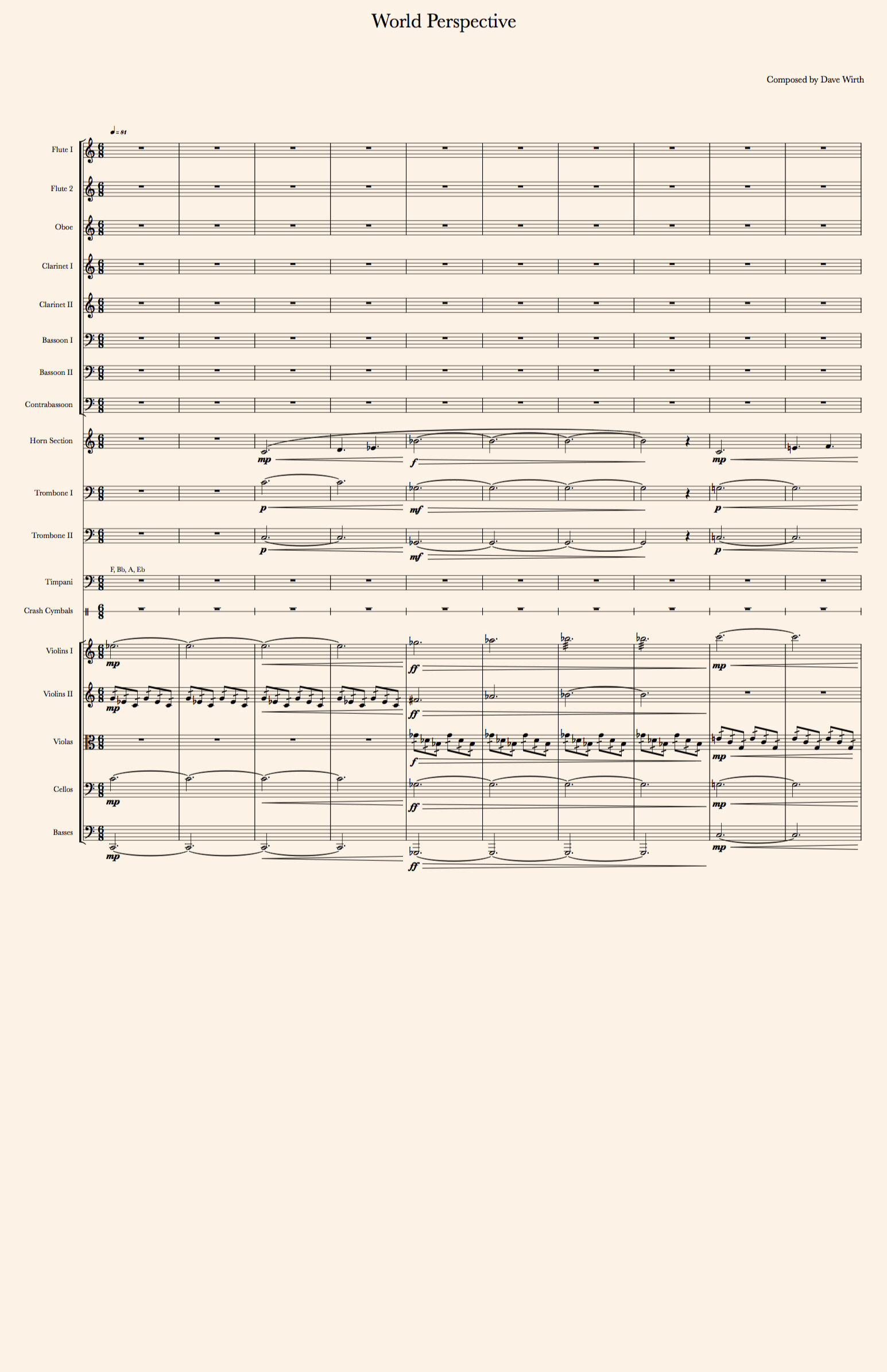
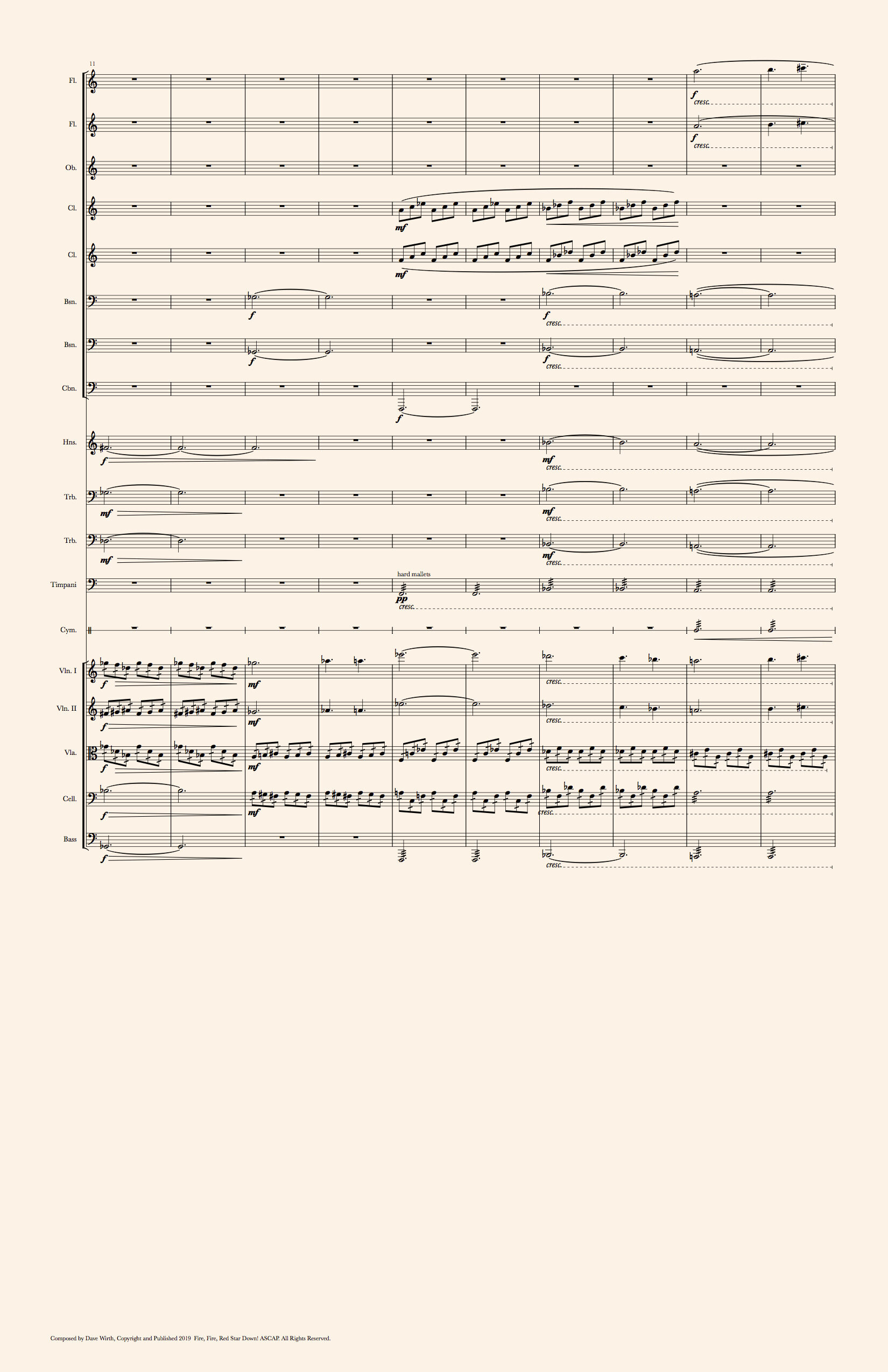
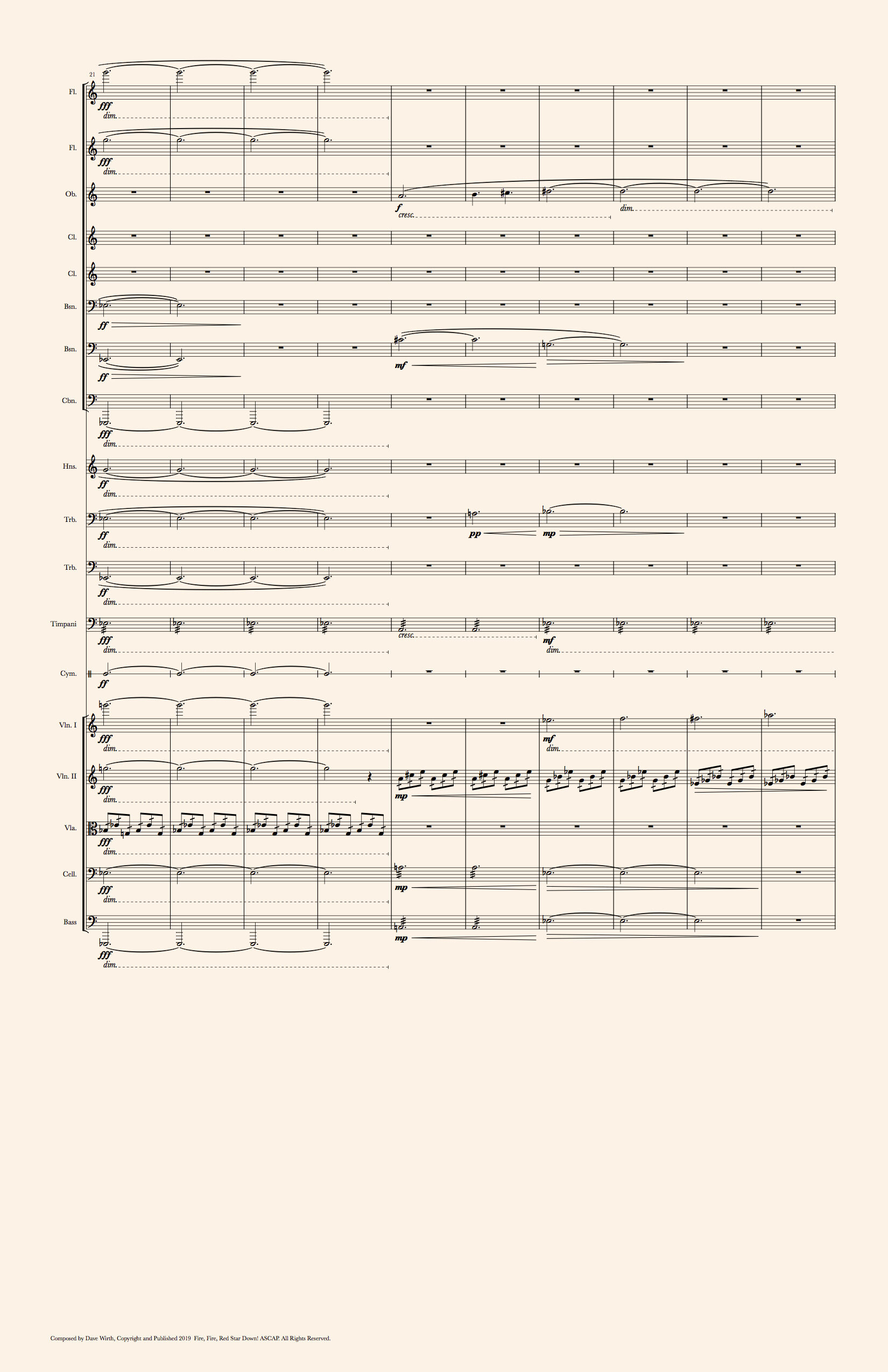
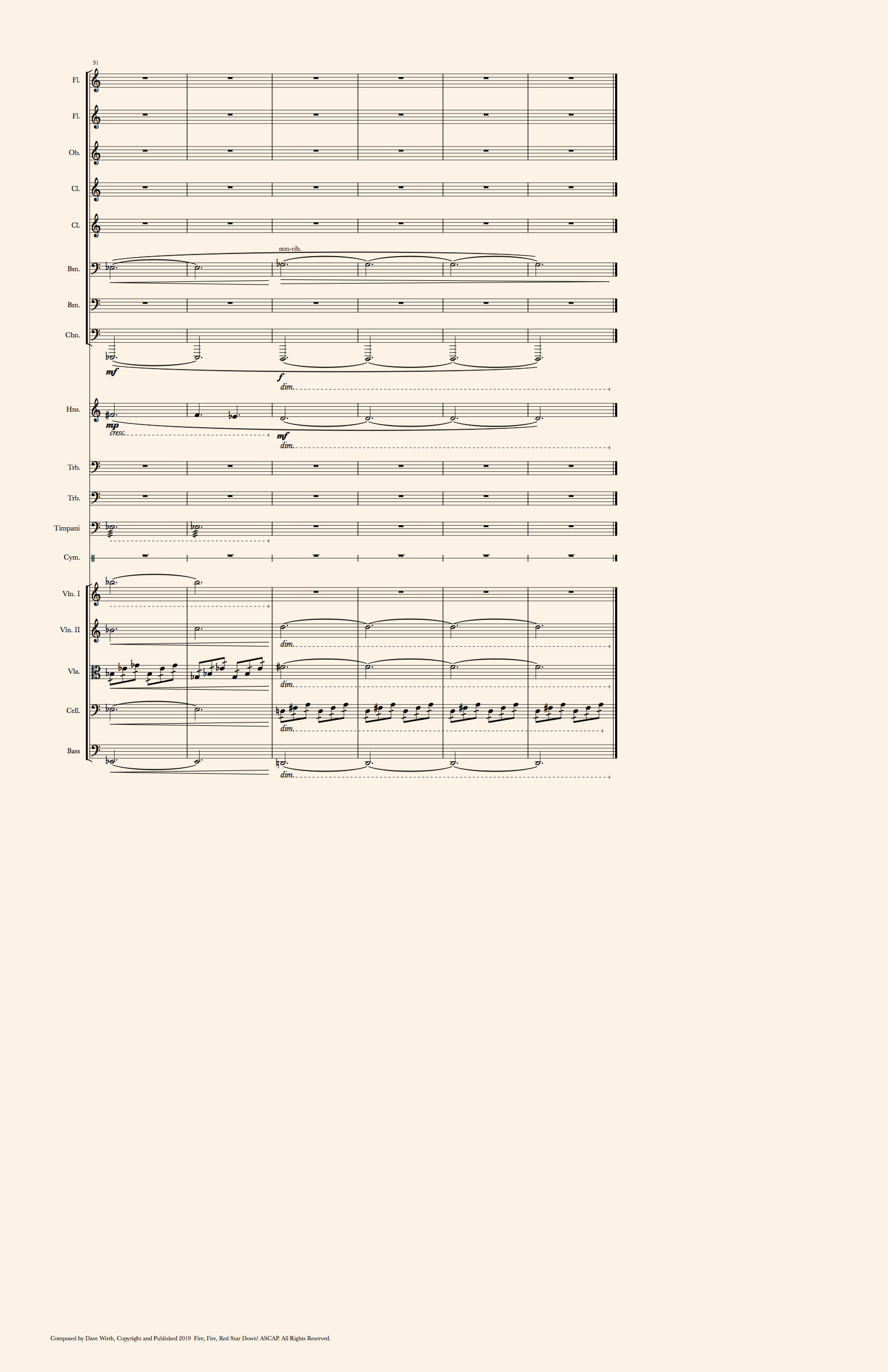
As a filmmaker, you must have experienced how big that sounded, right? That’s the point. I wasn’t going for subtlety. I was going for something really powerful. I wanted it to be loud, titillating, and I wanted to bring you along for a ride whether you liked it or not. I wanted you glued to the screen, inside that world, and I wanted to make it really hard to escape.
When the music achieves this over-the-top meltdown, it can enlarge the screen. That’s the aim. If you watched it all the way through, and if you were still in the narrative I presented when the video stopped, then that’s a success for world perspective.
The Disadvantages of World Perspective
I've been talking world perspective up, and rightly so. It's an essential type of film score. I particularly love this perspective for how thrilling it feels.
But if world perspective is so great, if all the Hollywood blockbusters are using it, every director should strive to absolutely use it everywhere, right?
Nah. Not even close.
World perspective does have some considerable disadvantages. When the scale is large, the tendency we composers have is to always go large with it. What about intimacy? What about the small moments? The details? The tendency is to stay big and never go tiny.
The film scores that consistently go large are in danger of glossing over the quietest moments, the nuances in a film. With a grand scale, it's so easy to just overdo it.
Further, if a composer prefers composing in a large world perspective, he probably won't feel as comfy composing for a movie that has a smaller audio perspective altogether. It's a danger, though we film composers are a hardy folk and love to be challenged to think outside of ourselves.
Speaking of which, there has to be a “smaller” sounding type of perspective, right?
Surely, there are audio perspectives that we composers can use that are more appropriate to capture the nuances of emotion, right?
Absolutely. Enter Relational Perspective.
Relational Perspective
I recently have been studying the movie The Sixth Sense. I think it is one of James Newton Howard's best scores. I also think it's a criminally underrated score. I felt that Howard managed to get into the minds of the two main characters beautifully because he captures nuances masterfully. [SPOILER ALERT] The relationship between a man who doesn't know he's dead, and a very troubled boy who can see ghosts, provided a rich relational context for Howard to work with.
To me, the strength of this score comes from the subtle push and pull of emotions we see between these two characters. When you listen to the score and watch the movie together, you'll notice that the relationship between Bruce Willis's character (the child psychologist) and Haley Joel Osment's character (the boy) is deeply rich and full of emotionally engaging moments. It’s sometimes perilous, sometimes, frightening, sometimes incredibly joyful. So many parts of the emotional spectrum are presented.
Though the audience doesn't know the dynamic of the relationship until the end of the movie, the boy knows the doctor is a ghost. These two characters are drawn together to solve not just the boy's problems but also to help Bruce Willis's character realize that it's time for him to move on. To me, because I'm a bit of a geek when it comes to how James Newton Howard composes film scores, he truly captures the dynamic of this relationship by zeroing in on this complicated relationship.
The Size and Scale of Relational Perspective
When you’re talking to someone who might make you feel a little uneasy, do you show it? No, of course not. But if there was a musical score to that moment, then the music would undoubtedly express that uneasiness for you.
Relational Perspective tends to have a small-scale and size because it can zero in on things that we feel as opposed to actions that we can see. This perspective is tiny when compared to the massive scale of world perspective because the object is emotion.
If relational perspective could speak, it might want to say:
This movie doesn't belong to the world that these characters belong in, but simply to the subtle push and pull of emotions that you can feel and barely perceive.
Relational perspective follows the emotion. We feel a tug of an emotion in this direction, we composers follow that emotion and see it through. We feel the gravity of emotion in a different direction, we composers follow it and see that through too. It’s all about emotion.
Relational Perspective in Practice
In practice, the relational perspective can work if it’s focused on the many emotions underneath a performance of an actor. If the actors are really connected, if they have that wonderful chemistry like James Stewart and Kim Novak did in Vertigo, than we are pulled into the emotions these two characters are feeling, fully and completely.
In working with the relational perspective, it’s my preference to lock into the actual actors’ performances. I enjoy seeing how two people interact, how there are natural beats of silence, how there are moments of heightened emotions. Chemistry is everything. I absolutely love reading the subtle body language of two very experienced actors in the throes of an amazing take. I love the subtleties.
To help illustrate relational perspective, I chose to do something a little different. I chose to illustrate a partnership between a puppy and cat, partially because it makes me happy but also because there’s a narrative in these images that I think lends itself to subtle emotions. Plus, it just makes me happy to look at the two animals interacting with each other:
Do you see how this example manages to capture some subtle emotions? How the emotion shifts?
As a director, it can make sense to use relational perspective throughout your film, especially if you have two extremely commanding performances from the lead actors that constantly push, pull, and tug at each other emotionally.
But, just the same as world perspective, there are disadvantages to defaulting to relational perspective. Sometimes, focusing purely on emotions means forgetting about some really important basic concepts in film scoring.
The Disadvantages of Relational Perspective
You might think that I'm a big fan of relational perspective judging by how much I look up to James Newton Howard. I look up to him because he's such a master of that perspective AND he can unify his score to be 100% cohesive. That, and he’s not afraid to go big and ballsy, like in the world perspective way. I'm looking forward to the lunch I'm going to have with him one day because I want to say how much I appreciate his work.
As I hinted at however, the danger with composing primarily with a relational perspective is that emotions can run wild and often pull a composer in many different directions. This can in turn lead her to create a score that is not unified. The composer is in too much temptation to create music that feels discombobulated, un-anchored, and has no sense of direction.
I also think relational perspective is one of the very hardest perspectives to master in film scoring because we're trying to catch not one, but thousands of butterflies in a small net. This gets really bad when we composers start to geek out about sample libraries, which offers us millions of patches to choose from… a special danger.*
And one of the biggest problems with relational perspective is that it can't often get it's head out of it's own ass and go big and crazy. When it's time to have the music go really large, composers under the relational perspective mindset might be too tempted to stay small. Why go large when the entire score so far has been about the small plays of emotion?
But anyways, relational perspective done well is incredibly powerful because it’s communicating an emotional perspective to the audience. The real question is whether or not this perspective is appropriate for your film. Sometimes your film might need this sort of intimate touch, and sometimes you might want to be more gruff and large. And if neither of these seem right to you, there are other options.
The next perspective I explore in this article is an interesting way to begin to capture both the scale of a world and the nuance of emotions but not be totally limited be either of them. I like to call it Character Perspective.
Character Perspective
It’s time to jog your memory: Think of the last film you watched where the lead actor was so commanding that you couldn’t help but see things from his or her point of view. You ended up seeing things from that one character’s eyes, to the exclusion of all others. You probably walked away from the movie still thinking about that character, how she should have done this, how he should have done that.
When one character is so strong, so potent, and so compelling that we end up feeling what this character feels, seeing what this character sees, and living vicariously through the performance, a score might be done really well if it takes that character’s point of view throughout the film.
If the character experiences something very large, we can feel it as the audience, and the music can feel as large as the world. If the character experiences something very small and subtle, the music can feel just as small as the tiniest emotions. Character perspective can go as large or as small as it needs to, as long as it describes a character’s experience well.
One of the best examples of character perspective, in my opinion, would be Room. Though Brie Larson got the accolades, it was the perspective of the boy Jack we got to see throughout the movie, played by Jacob Tremblay. If you watch closely, we see mostly what the boy sees throughout the film. We experience what the boy experiences too. We hear what the boy hears, too. Stephen Rennicks‘ score is a delightful listen too, easily capturing the boy’s perspective.
But does character perspective only work if there is one strong character? Well, there are other ways to apply character perspective in film scoring that can revolve around groups of characters, too.
The score for To Kill A Mockingbird is an excellent example of a film score taking the perspective of a group of characters. Elmer Bernstein's score for the movie is whimsical, delightful, and light. It's a fantastic juxtaposition to the subject matter. To give context, Elmer Bernstein couldn't find the right tone for the score until he wrote the music from the childrens' points of view. Isn't that interesting?
Another great example of character perspective that takes the perspective of a group, in my opinion, is the score for Sicario. You can agree with me or not, but it is my belief that the soundtrack, as large as it sounds, doesn't really take on a world perspective, nor does it take on a relational perspective, though both of those scales are present in that score. What if you listened to the score as if the music came from the perspective of the cartel?
The thundering drums, the orchestral crescendos and rips, the sound design and synths, the distortion on the drums... The music is slow; Dangerously teetering on the edge. To me, that movie is all about trying to control the uncontrollable, aka controlling the cartels in Mexico. The characters are all invested in seeing that come to fruition (though with radically different ethical standpoints). All the while, the supremely wild menace of the cartel is banging away in the background, threatening to tear everything apart.
Interesting slant on that score, right?
Character Perspective In Practice
What I find really interesting about character perspective is that you can choose to find really odd perspectives, sometimes just barely beyond the edge of consciousness.
For this example, I chose to illustrate an unconventional perspective in horror film genres. The idea: Sometimes the main antagonist isn’t all bad. He or she just seems bad, but there’s a little weird altruism hiding inside. It’s the actions of this character that are absolutely horrific, but the motivation isn’t all bad. One need not look further than Thanos in Avengers Infinity War and Endgame to see the merits of a slightly altruistic bad guy and how rich that can be for a narrative.
In the video below, you’ll see a series of images that are common to horror films. You’ll see a woman walking around, you’ll see some indistinct charcoal sketches, and you’ll see a color palette that is grimy and gloomy. You’ll probably assume that the woman is possessed, and you’ll probably assume that the music is trying to express the shock and horror of that possession.
I wanted to express that there was something more than just extreme evil going on. Extreme evil that is 100% malevolent in a movie is boring! Instead, this sketch was more about the so-called “demons” possessing the woman in the photos. What if they weren’t demons, but were lost souls looking for redemption by possessing a living woman?
With this perspective, I naturally had this thought: “Wow, they must be desperate to get out of wherever they are.” Then, the whole mini-movie came together. We have a flock of misunderstood souls clinging to a living human being, but they are so desperate to escape that they dragging her down with them.
To achieve this perspective, I took a simple piano piece that has it’s own strange tonality and I worked it to be incredibly unstable with the help of an orchestra. I wanted it to capture the perspective of the lost souls desperately wishing to escape their situation but doing it in a terrible way:
Picking a character perspective like this can work wonders for your movie. For you, as the filmmaker, do you see how this really strange point of view adds a level of subtlety that can challenge your audience to see something more? To perceive that there is more going on? Can you see how doing this can make your story stick out and stay with the audience a bit more?
The Disadvantages of Character Perspective
Writing from a character's or a group of characters' perspectives is a different way of looking at the typical film score. It's not the world that most important, it's how that character views that world. It's not the emotions in the film that matter nearly as much as that character's perception of the emotions.
Of course, there is a slight problem: What if the character cannot actually see the largeness of the world? What if the character cannot perceive the push and pull of emotions? What if a character is totally cut off from his or her emotions altogether, and there are important events happening in the emotional world that he or she can't see?
Since character perspective is so localized, anything not perceived is in danger of being discarded. I'm certainly not suggesting that a movie has to STAY in a character perspective the entire time. Sticking to just one character's perspective throughout a movie has to make sense. It does for Room, though there are quiet moments outside of the boy’s experience that we get to experience as well.
The MELANCHOLIC Disadvantage to World, Relational, and Character Perspectives
World, relational, and character perspectives are all very serious ways of approaching a film score.
The world perspective is so big and large, crushing in it's perspective that it can easily be overwhelming and overstimulating. The relational perspective is smaller and more intimate, a bit like a narrator in a regular story, but can easily lack focus and direction. The character perspective can be large or small, depending upon the worldview of the character or group of characters that we are to get the viewpoint of, but only of that character.
All three perspectives tend to have a possibility for a repetitious monotony of seriousness, and sometimes we just don't want to be so damned serious. Sometimes, we just want to have some fun!
So, why can’t we?
Why can't we laugh and be silly? Why can't it just be light and airy once in awhile?
I'm afraid that without a little levity, all the movies out there would be a ridiculous bore. And it’s the levity which Juxtaposition brings that can shake up the vibe in a lovely way.
Juxtaposed Perspective
Did you ever watch You Can't Do That On Television on Nickelodeon when you were younger? There was a point in every show where they'd have the opposite sketches; All the characters did everything backwards.
People who loved hamburgers all of a sudden hated hamburgers. A very frugal family instantly became spendthrifts. A girl who wanted nothing to do with a boy begins fawning over him. All of the characters knew this would happen on every show, too. "Oh... I get it. It's the introduction to the opposite sketches." (this was also the show where if you said "I don't know" out loud, you would get slimed. It’s a fun YouTube rabbit hole).
Juxtaposed perspective is like the opposite sketches: Find a song that makes a scene feel radically different than what's happening in it. In doing this, you would be taking an approach that is from the perspective of humor and irony. There is a rich history of juxtaposition to exemplify this wonderful tool for film music.
Take the first scene of Watchmen (2008). In this scene, we see the Comedian fighting a masked mystery man in his high-rise apartment. This fight scene is brutal! But it’s the fact that Nat King Cole's Unforgettable is playing in the background, a slow moving and deeply emotional tune, that the scene feels light. It’s even… comical. The scene culminates with the Comedian falling out of a high-rise window in slow motion, while the song slowly comes to an end after he hits the ground and dies.
There are a couple more examples of juxtaposition that I think are worth noting. There's Michael Madsen's character in Reservoir Dogs cutting off the ear of a captured police officer to Stuck In The Middle With You. Then, there's Uma Thurman's character preparing for a battle in a Tokyo nightclub under the sway of the 5 6 7 8's lovely song Woohoo-oo-oo-oo.
For the most part, juxtaposition has been achieved through licensing music to be synced to picture. What is intoxicating though is that composers haven’t had the chance to adequately explore juxtaposition directly. What I mean is that composers aren’t often asked to create cues that are inherently juxtaposed and opposite to the action of the cue. Instead, directors pay lots of money to use music that was already commercially released, but there's no reason why composers couldn't actually compose juxtaposed music to help deliver some levity.
Juxtaposed Perspective in Practice
Now onto the fun part! For this example, I decided to do something really silly. After all, I love to embarrass the people around me by singing in an operatic voice. Why not use it?
Juxtaposition brings levity, and opera can be very, very comical:
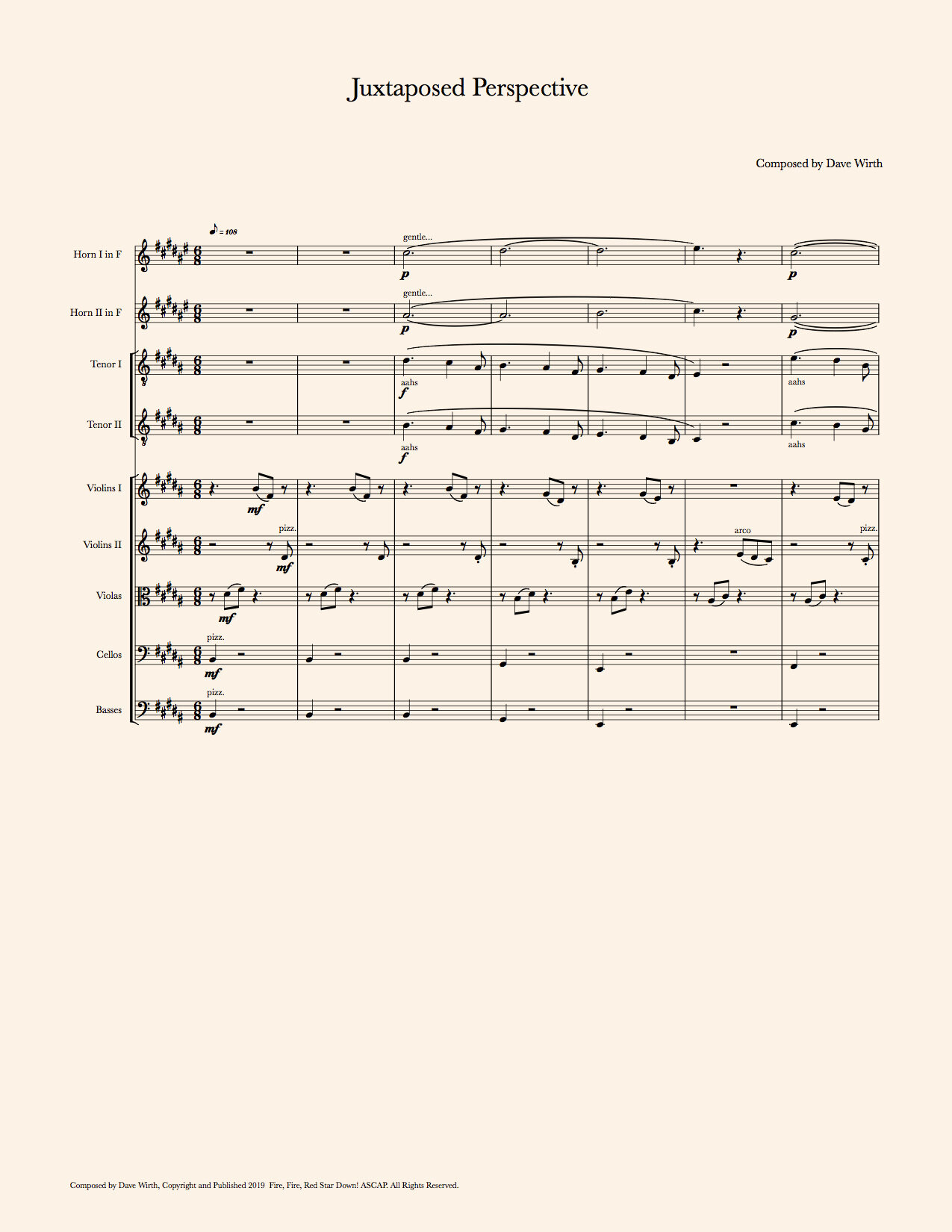
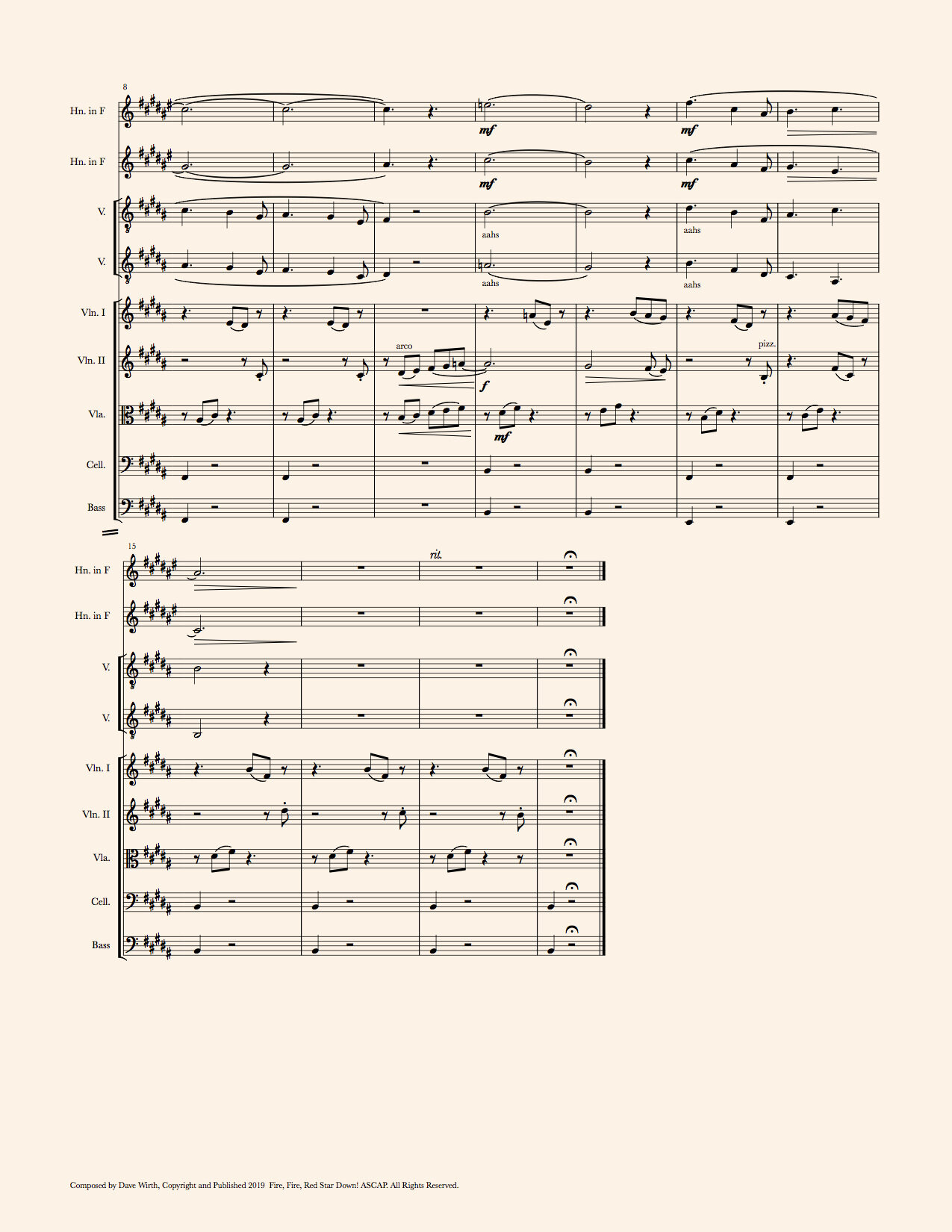
I could have scored this mini-movie a lot differently, of course. I could have tuned into the emotions of the characters. I could have taken a perspective of the office looking in shock and horror at this fight. But really, what’s the point of that when we could just make it really funny?
By using juxtaposition, this entire scene becomes lighter and enjoyable. Funny! The use of juxtaposition is a great way to keep things light, but like all the perspectives I’ve discussed here, juxtaposition has it’s disadvantages.
The Disadvantages of Juxtaposition
The following quote from Rainer Maria Rilke in his Letters To A Young Poet is an excellent way to introduce one of the main disadvantages with juxtaposition:
Today I would like to tell you just two more things: Irony: Don’t let yourself be controlled by it, especially during uncreative moments. When you are fully creative, try to use it, as one more way to take hold of life. Used purely, it too is pure, and one needn’t be ashamed of it; but if you feel yourself becoming too familiar with it, if you are afraid of this growing familiarity, then turn to great and serious objects, in front of which it becomes small and helpless.
As you might have guessed, juxtaposition can be ironic, and that irony can be overused.
Another way to put it: Choose your moments to use juxtaposition, or else you'll lose the element of surprise.
There's another issue too. I think there is a dark side to using too much juxtaposition. Have you ever met an incredibly sarcastic person? Of course you have. They are everywhere!
If you're anything like me, you'll wonder why this person spends so much of his or her time masking how they really feel under a witty, sarcastic result.
Sarcasm, to me, hides what's truly beneath the surface. And further, it's not unreasonable to think that sarcasm is a gateway drug to cynicism. You might disagree with me entirely, but I've seen sarcastic people turn incredibly cynical later in their lives. And cynicism in general? Whoa... I'd rather not be around that energy if I can help it, thank you very much!
This is the danger of using too much juxtaposition: You might unwittingly present cynicism to the audience. If that's what you're going for, then do it by all means. But cynicism is incredibly exhausting.
I think a good guideline to keep in mind is that juxtaposition done with tact and timing is intensely powerful. But when it's relied upon as a staple, it's a little overbearing.
Use it with caution, not abandonment!
I've been focused heavily on narrative film scoring perspectives throughout this post so far, and how fair is that? There are so many hard-working documentary composers out there and I wish to tip my hat to them. Therefore, I only wish to share just one final type of audio perspective (though there are many others), and it's one I often hear in documentaries: Idea perspective.
Idea Perspective
Though it's not what I enjoy playing anymore, I certainly appreciate and love listening to jazz. To me, jazz is like an interlocking and evolving web of ideas. One idea bubbles to the surface. This first idea it inspires new ideas from others in the group, which of course inspire more new ideas. Jazz done well is a ton of ideas being built upon.
When I think of ideas in the real world, I also think of the evolution of scientific inquiry. Though I will admit that I definitely don't have an expert view, what seems to make scientific inquiry so powerful is that scientists are always questioning what ideas were presented before in the quest for an ever-expanding truth. The ideas of the past inspire the ideas of the present and future. There always seems to be a new paradigm that disproves an older theory. A decent example of this is how quantum physics shook up the paradigm of Newtonian physics.**
Idea perspective is when one idea leads to another, which leads to another, and leads to another, and so on. It's really fun to dig into as a composer!
Idea perspective has an unmistakable vibe of wonder, awe, and a feeling of brightness that serves documentaries well.
Speaking of which, there are some really great examples of this perspective in action. One of my favorite documentaries, just because I'm a big appreciator of typography,*** is the movie Helvetica by Gary Hustwit.
Helvetica is all about the history and impact of a font (or to be more accurate, a typeface) and how it's introduction changed the look of our modern cities as well as graphic design, forever.
Based on our discussion so far, you might be tempted to wonder if the music represents the actual typeface of Helvetica, but I really don’t think it does at all. The music on the soundtrack tends to bring us on a journey of an idea from it's beginnings in 1957 to ubiquity in advertising and street signs in American cities in the present time. The music represents the rich history and impact of Helvetica, how one thing led to another, how one idea for the use of Helvetica sparked a revolution in advertising and graphic design.
Idea perspective has an unmistakable educational vibe that seeks to inform us of how ideas evolve. It's full of wonder, of awe and learning. Idea perspective is just about perfect for documentaries. It just works.
Idea Perspective In Practice
In the following video, I strung together a bunch of photos that showed us the design and then the construction of a building. I composed in a way that weaved together a bunch of small inspiring ideas, ones that create a structure. I wanted the music to weave ideas upon each other, to move the story forward:
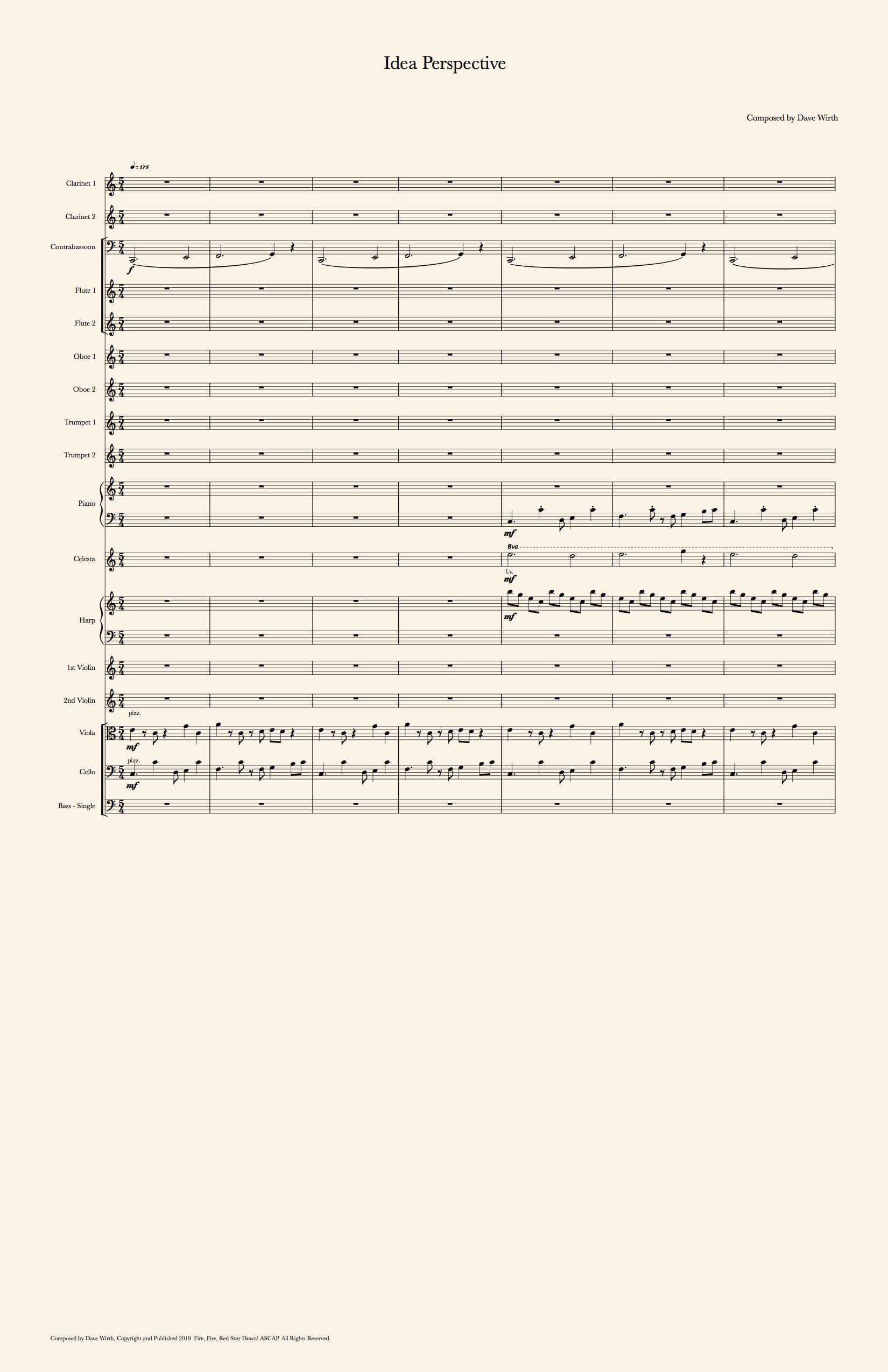
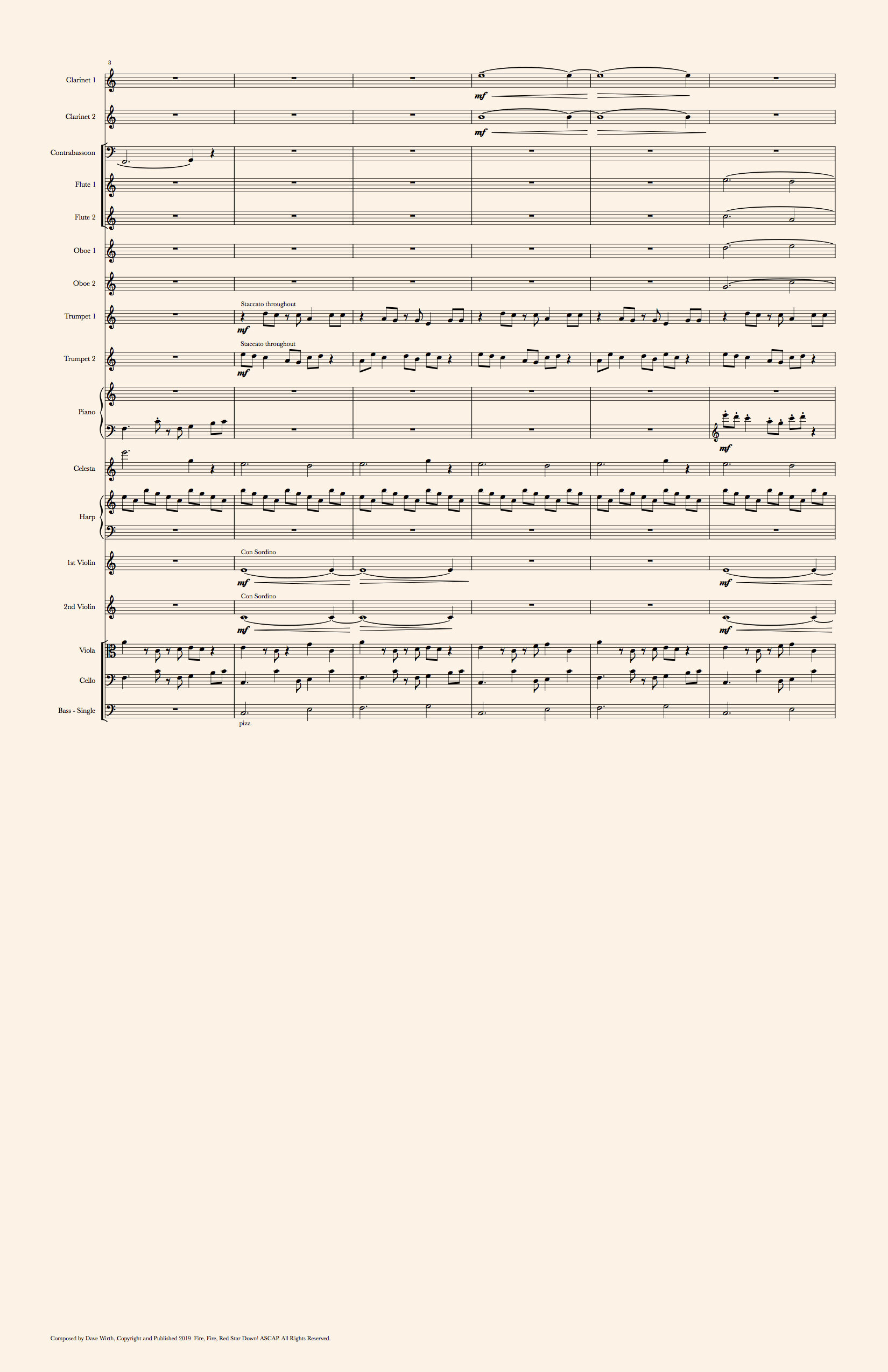
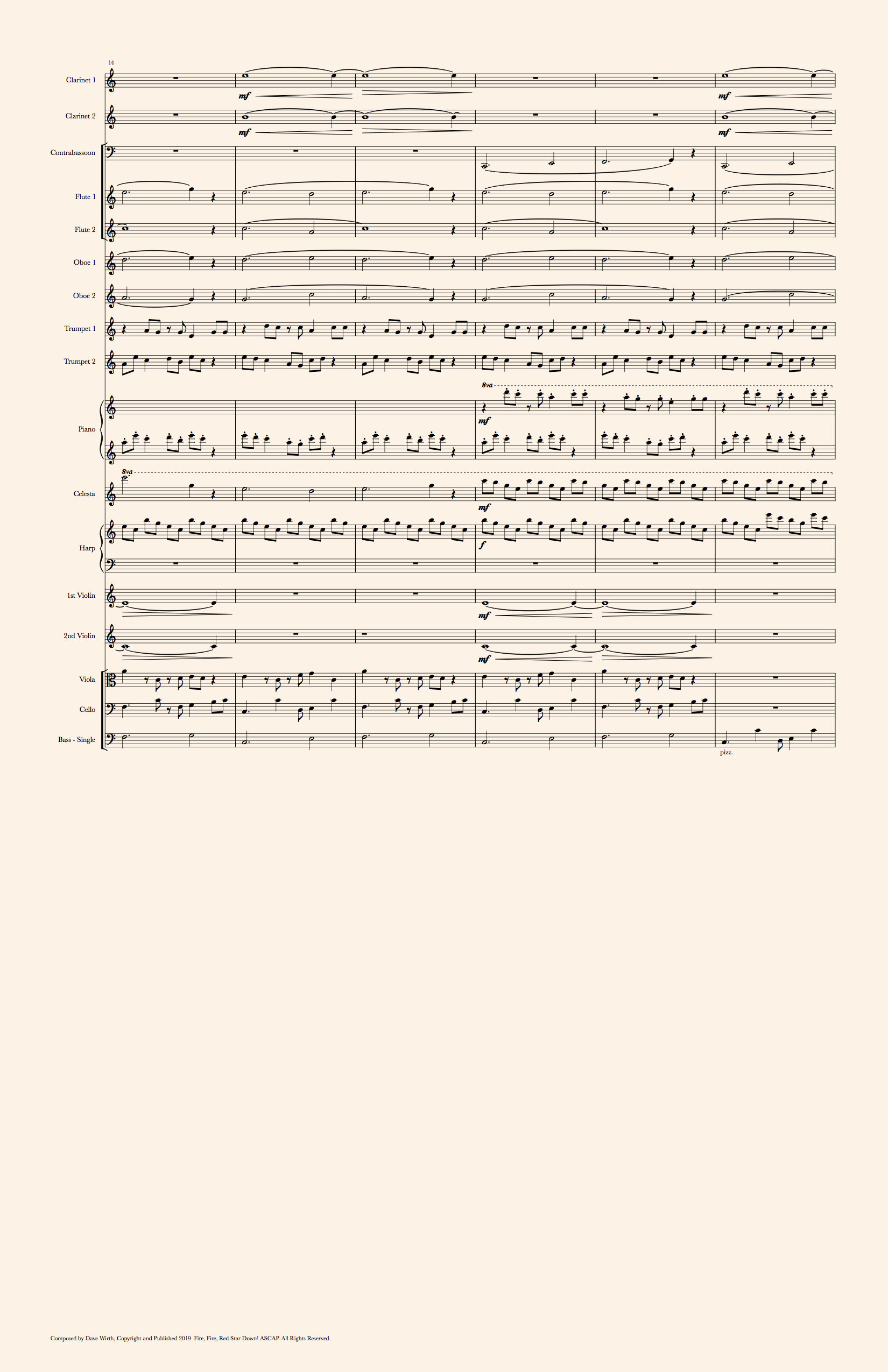
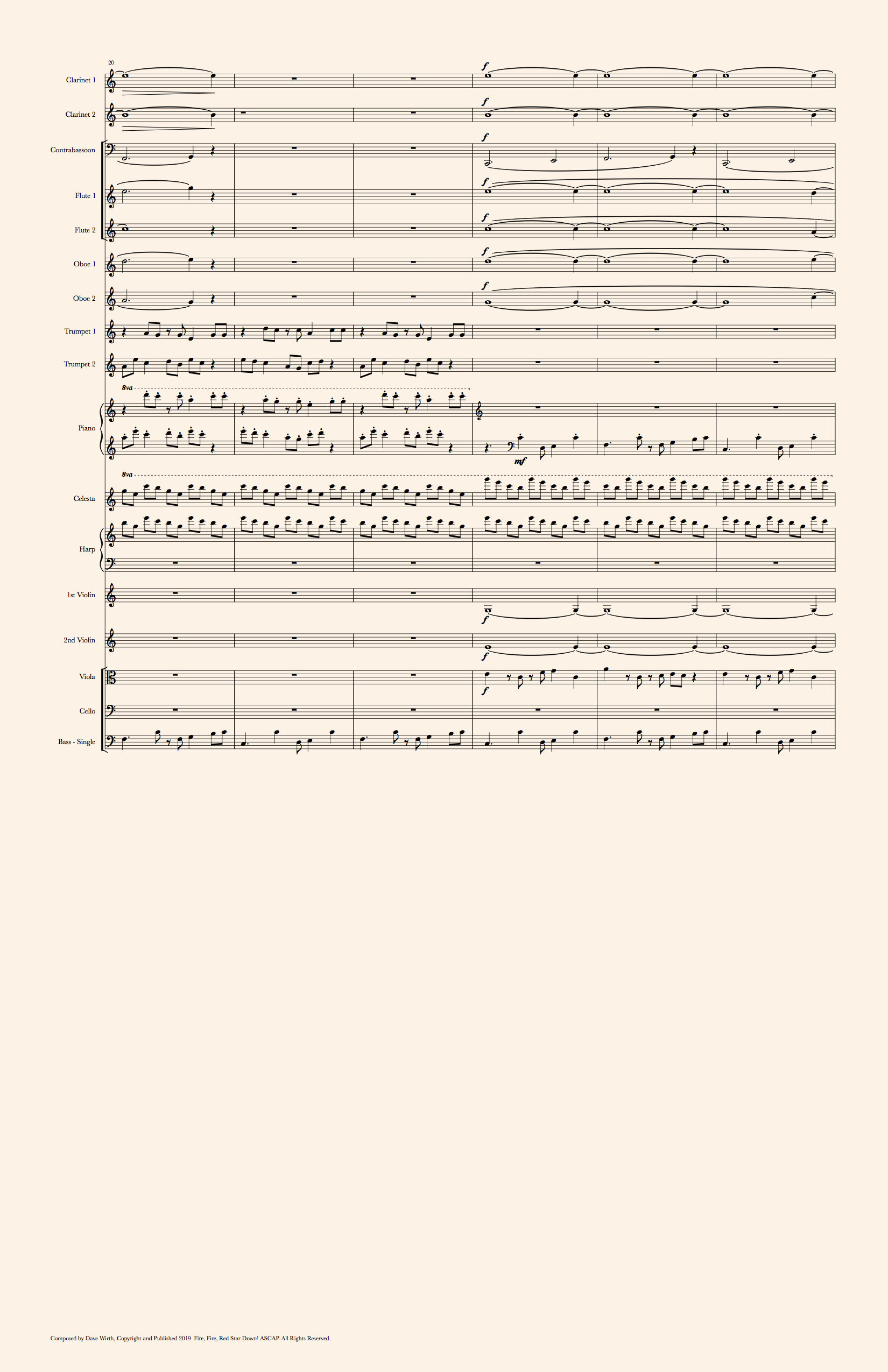
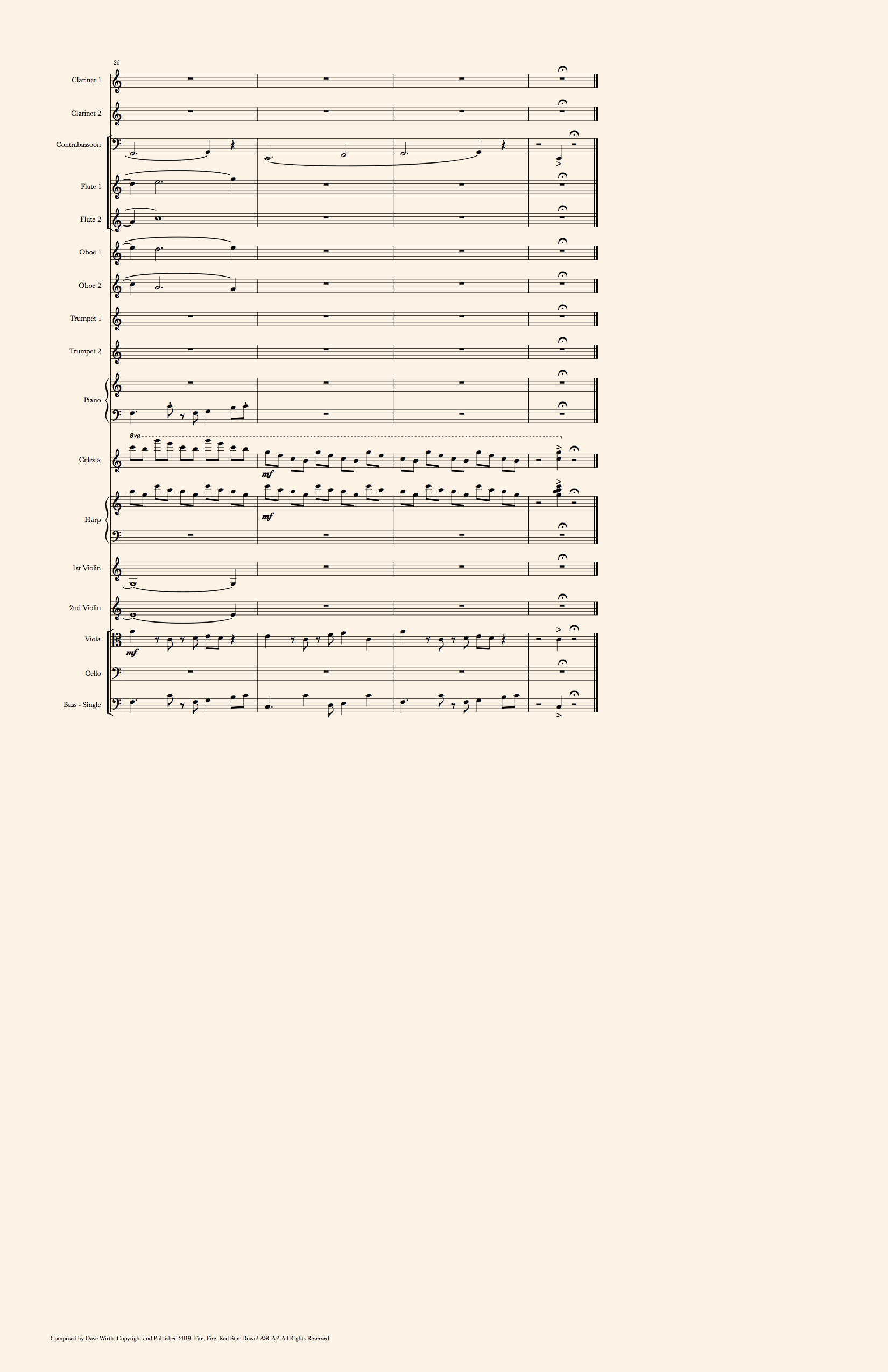
The Disadvantages of using Idea Perspective
Ideas have a natural way of building upon themselves. When we’re in our element and the ideas are flowing, there is an unmistakable vibe of growth. But it’s strength in expressing growth is also it’s weakness. Sometimes we don’t want to express the perspective of growth. Sometimes we want to express death. Sometimes, we don’t want the audience to feel that air of awe and magic.
Further, while idea perspective lends itself so naturally for documentary features, it might not be the most appropriate for slower moving dramas that really don’t need a lot of movement.
I like to cite Moonlight as having a perfectly paced score. Can you imagine if you took the music of Octopus Project and played it while watching Moonlight? I suspect it would feel terrible! Octopus Project’s music has such a light, bright, zooming sound to them that it seems almost cruel to think of watching Moonlight at the same time. It works so much better with the slow moving score that it has.
This leads me to the main issue, the main reason why it’s a good thing to look at so many different audio perspectives.
The perspective you choose must be appropriate for the film you’ve created.
If you decide not to think about what type of perspective is appropriate for your film, you are missing one of the most powerful ways to communicate your perspective and have the most effect on the audience. Further, if you’re interested in growing your career and experiencing more success, it’s my strong belief that you are shooting yourself in the foot by ignoring it.
Let’s not do that, okay? Let’s now talk about how to get your movie paired with the most appropriate perspective, one that will definitely make your story more vibrant.
Determining The Right Perspective For Your Film
It’s silly to assume that a one-size-fits-all treatment is going to work for each and every story you ever put together.
Creative movies need creative scores that match the perspective that the director wishes to communicate to the audience, and sometimes that requires thinking outside of the box. Sometimes it requires breaking all of the rules.
Further, the composer has a big responsibility to make the movie incredibly enjoyable. It’s all too easy to use the wrong audio perspective and pull the audience through a movie with a meat hook through their jaws. Even Quentin Tarantino doesn't often use composers, stating “I just don’t like the idea of giving that much power to anybody on one of my movies.” (Milian, 2009).
To help us do better work, I think considering different audio perspectives can help us all tell a better story.
If you just want a score that sounds like [insert famous film composer here], I beg you to consider that a different approach (and perspective) could be more appropriate. If you can get a more appropriate film score, than your film has more power to communicate it’s perspective!
The issue of scale, of vastness, is also really important when you're nailing down how you want the score for your movie to feel. When you watch a movie like Room and blast the soundtrack of Blade Runner 2049 in the background, can you see exactly how uncreative and excruciating and inappropriate that is?
If budget isn't a concern for you, you don't necessarily need to go world-perspective big with huge orchestras or incredibly large synth soundscapes. You could start by asking, "what is the size of my story?" Or, "Who does my story belong to?" I would highly recommend that you answer these questions before you even reach out to a composer. Doing so can give you a sense of mastery over the process of choosing the correct person for the job. After all, many composers can become well-known for a particular audio perspective.
Alas, there are so many composers out there, right? How do you choose the right one?
Finding the Right Composer for the Story
If you met a composer randomly, you must keep in mind that just because you get along with her doesn't mean she’s the right woman for the job. You must keep in mind that just because he’s relatable doesn’t mean he’s the right man for the job. You have to get to know what makes a composer tick. To help you with this, I recommend that you interrogate composers!
Here's some questions I would ask if I were interviewing composers:
"How much experimentation have you had with a very large-sounding orchestral score?"
"When you want to express something musically that's really small, what do you do? What is your process?"
"What sorts of things do you do when you want to get in deep with what a group of characters are feeling?"
“How do you work to unify a film score when there is so much happening inside a story?”
"When you approach a documentary, what anchors you in your approach?"
If you've made a choice and you're starting to work with a composer for your film, discussing audio perspective is a solid move to make, even before the spotting session begins. I am convinced that it's important to take the time to explore the film, talk about the film, and get in touch with the film before you set the composer loose on it. Basically, you’ll prime the composer to deliver a unified score that digs as deep as the story that you wrote.
Beyond that, you’ll have a better chance to delivering a perspective to the audience that has the opportunity to change them, that will stay with them.
You have a chance to help them expand their horizons.
Communicating Your Film’s Perspective With Music
Choosing the right audio perspective matters. Vital. When you choose correctly, your film becomes more powerful because the perspective you are trying to share with the audience is that much more compelling.
If we want to communicate the overall vastness of the universe, we have to come from the universe's perspective. If we want to get up close and personal, we need a smaller and more intimate perspective. If we want to express a character’s perspective, the music really needs to come from that character. And sometimes if we want a humorous perspective, a little juxtaposition could be just the ticket.
You can transport the audience inside the perspective that owns the story. Like Chiron in Moonlight, like the cartel in Sicario, like the world in Blade Runner 2049, like the children in To Kill A Mockingbird, you can bring the audience right inside the movie, to feel it deeply, to understand it, and to be enlarged by the experience.
This is why it’s so important to match the audio perspectives in a film score to the perspectives in the story. That’s why music is so important. That’s why it shouldn’t be an afterthought, an addition to an already stretched-thin budget.
Music is the best way to change and expand the audience by effortlessly and non-invasively delivering a fresh perspective.
And I really mean it: If we can take charge of the stewardship of communicating a new and fresh perspective to the audience, if we deliver it with care and careful consideration, we have the opportunity to improve people’s lives.
We can offer the shock that someone in the audience needs to become a better person altogether. Why can’t we do that? We aren’t necessarily saving lives like a doctor, but why can’t we have just as much effect on the world around us by helping people see that there is a world beyond what their eyes can see? Why can’t we help people be expanded in their lives?
The right music is a steward of the audience's experience of a film. It is a way to deliver an extremely compelling perspective. When the score is done appropriately for the perspective that the story wishes to communicate, it has so much power to expand the horizons of the people watching the film. It doesn't matter if it's world big or character small. It doesn’t matter if the perspective is as big as the universe or as small as a butterfly.
It also doesn’t matter if you spent $1,000,000 on the score or nothing at all.
What matters is that the music adequately expresses the size, scale, and perspective of whomever owns the story. When it does that, you can count on that movie having incredible power and much more success.
And that is my wish for you.
Please, leave me a comment!
Or, feel free to reach out to me.
More Articles on Film and Music
Footnotes
* I literally got a headache after writing this sentence.
**If you're interested in a really interesting scientific explainer video, check out the Double Slit experiment. This blew my mind.
***This entire website is set in Adobe Jenson Pro, a renaissance type that was made by Nicolas Jenson, a man so in demand that he kept 12 printing presses running at the same time. Aside from being a beautiful typeface, I love the history of it and the fact that it's been around since the 1400's. Robert Slimbach did a great job with the revamping of it.
Facsimile Scores
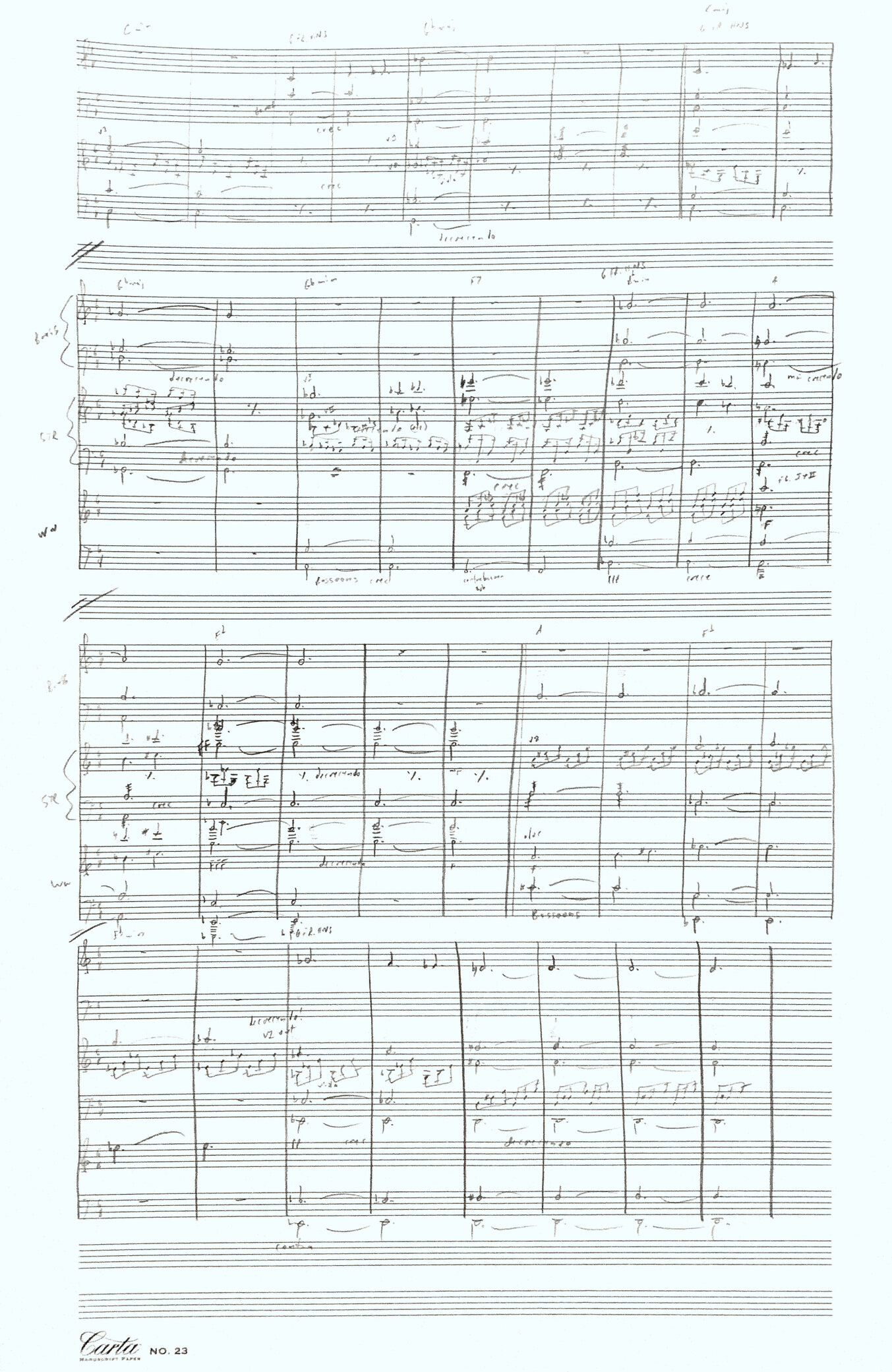
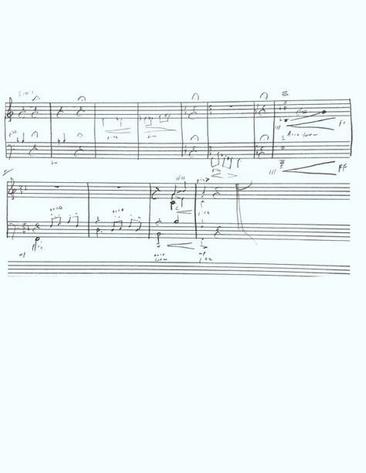
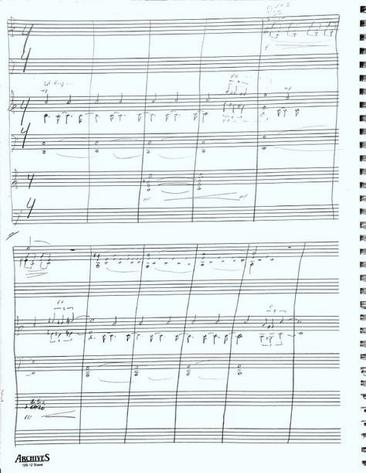
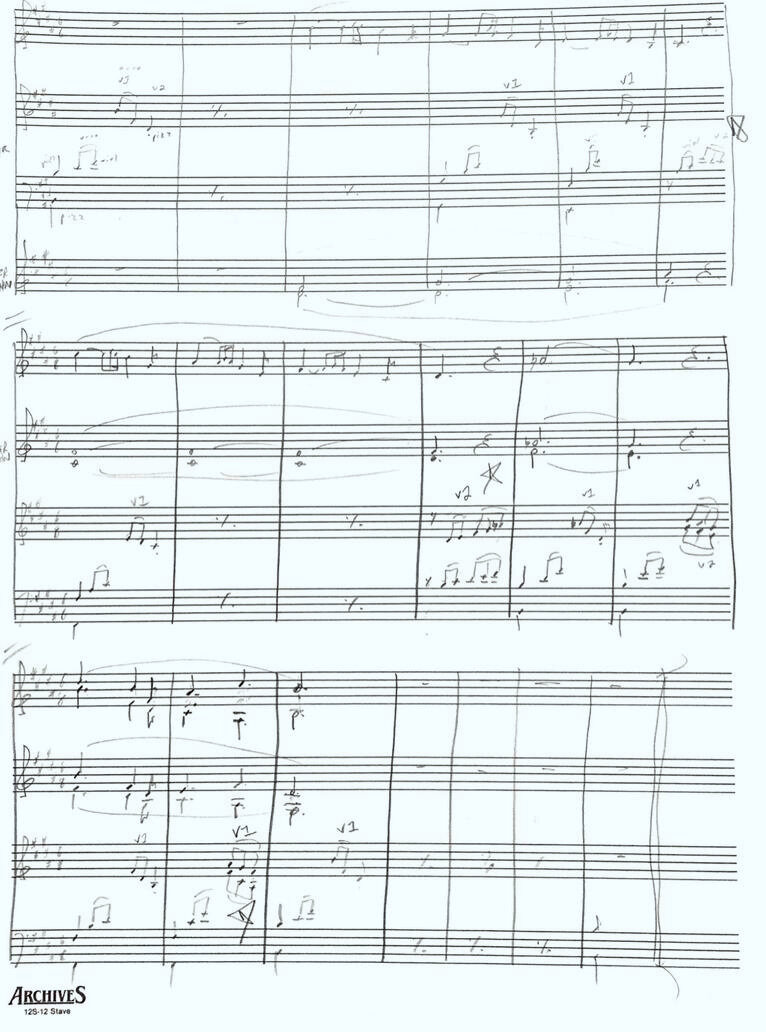
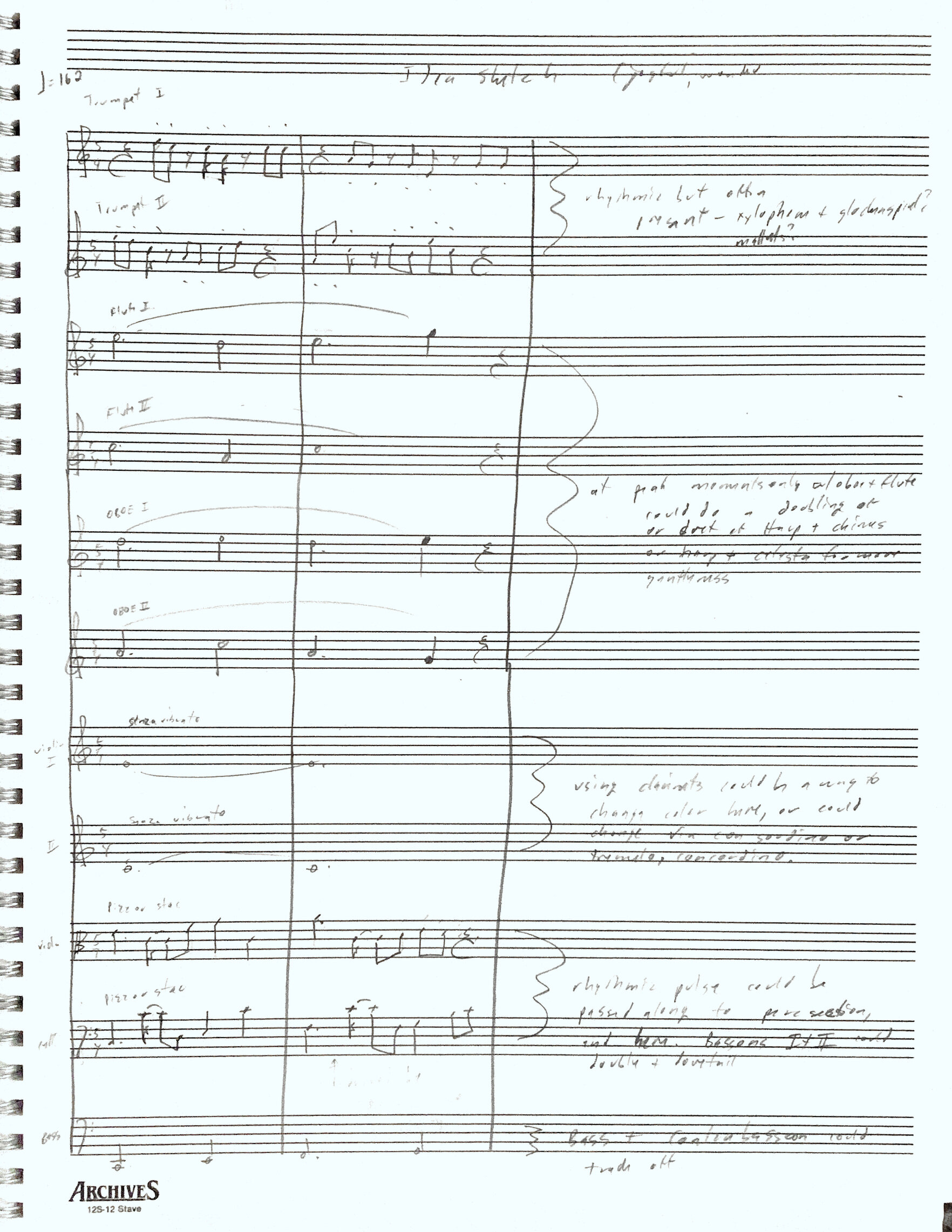
Copyright Notices
All music that appears on this article was composed by Dave Wirth, Copyright and Published 2019 Fire, Fire, Red Star Down! ASCAP. All Rights Reserved.
So grateful to find this story:
Toronto-based pianist Richard Herriott got out of his flat just before it was completely engulfed in flames. Though he was lucky to escape with his life, everything in his apartment, including irreplaceable manuscripts of musical compositions, was destroyed.
Newly homeless and in shock, the entire community of musicians and music lovers rallied around him, and raised over $15,000 to get him back on his feet.
Richard Herriott:
"I just feel so fortunate that I can still be here to sort of appreciate it," he said.
"That's what's getting me through everything."
https://www.cbc.ca/news/canada/toronto/toronto-s-music-community-rallies-to-support-beloved-pianist-after-fire-destroys-his-home-1.5370525
About two months ago, my friend WT from AMBO Art and I went to a flea market in Texas. While there, we ended up finding this little gem, a Little Wonder Microphone:
The microphone didn’t work. The wires were from the original kit, and this little beast was assembled circa 1935. The wires almost fell apart in our hands, but we thought, “Let’s open it up and see what we can do with it. It’s already broken anyways”
The first day, we opened up the bottom of the mic, and began to open up the capsule. We didn’t make it too far:
The capsule needed a different tool to crack it open, though we did try this:
I thought, “Oh well. It’ll make a nice paper weight.” Two months later I brought the mic back simply to see if anything could be done, and that’s when it all came together.
The Dremel and a drill press took care of the rivets holding the capsule in place:
What we found inside was a cause for wonder because the transducer was a cylindrical piece of wood with a metal plate:
Since we had the capsule off entirely, and also since we just wanted to make this dead simple, it was decided to add a Piezo pickup in the capsule where the old transducer was, load up a quarter inch jack, and put it all back together again. This would make it usable without any extra equipment.
So, how does it sound? Pretty awesome on a guitar alone:
Then I thought, “What would it sound like in a mix?” Here it is on an electric guitar (left) and a piano (right):
Very happy with this new microphone! Gonna have to get my friend another round of cigars for his help…
All music composed by Dave Wirth, Copyright and Published 2019 Fire, Fire, Red Star Down! ASCAP. All Rights Reserved.
About Our Campaign
The Mumbler is a short film where mumblers are quarantined to an industrial treatment center. The film follows the story of Willow, a young woman with a decimated speech enhancing device struggling to get a replacement. The Mumbler was shot in January of 2019 and completed in summer 2019.
Except for the recording of the live music score, The Mumbler is now ready for festival submission. Recording a live music score with real musicians will not only complete the film but will dramatically increase its value. Here’s how:
The Mumbler’s music takes the perspective of the main character, Willow, a smart young woman who feels suppressed by others because of her inability to communicate. Her experience is not far away from 18th-century kings and queens who were often harassed and muted by court intrigue. By using classical period music as a source, the score encapsulates the frustration that Willow feels while at the same time keeping the film light and comedic in feel.
What We Need & What You Get
Our fundraising goal is $2,000. To properly perform and record the score, $2,000 will get us:
French Horn (instrumentalists): $100
Two Bassoons (instrumentalists): $200
Score Supervisor: $300
Recording Engineer: $400
Recording Studio Time: $500
Microphone Rentals: $200
Equipment Rentals: $200
Catering: $100
If you are kind enough to donate to our film, there are a plethora of rewards to be given out, from free downloads of the score, special edition posters and T-Shirts, to a vinyl record and even an executive producer credit. Additionally, some tiers of support will receive access to a live stream of when we record the score!
More than anything else, you'll have the distinct pleasure of helping us do great work on a film that means so much to us.
The Impact
By far, most independent movies have scores that are computer generated and synthetic. There's a trade-off when movies are made with fake instruments: There is a remarkable dip in the emotional impact of the story.
When real musicians play the film score, it's much more personal. The musicians can extend their humanity to the film. Computers might be savvy time savers, but they'll never be able to beat human beings when it comes time to bring emotions to the table and really help the characters and the story shine.
Your contribution will help us bring a beautiful humanity to the film. So few producers and filmmakers really care about the music to the extent that we do. It is our very strong opinion that a film is not done until the music feels appropriate for the story.
Your contribution will help The Mumbler be more memorable and enjoyable. Your contribution will will also enable a bunch of non-conformists make a movie that completely bucks the filmmaking trends that seem to scream "quicker is better." No! We want to do this right, and we will make it happen!
Risks & Challenges
We believe that the risks are lower for The Mumbler than for most other projects. We have a fantastic score supervisor and producer Shelly Eager, who is executive director of Cinematic Symphony, handpicking the best possible talent for the recording. With Shelly's help, we have figured out that the actual recording of the score will take us 3 hours or less, with one break. Additionally, Shelly triple-checked our score to make sure we didn't make any mistakes in writing for french horn and bassoon (we didn't!).
Our audio engineer Eddy Hobizal has also agreed to record the film score in his home studio, Treehouse Recording Studio, in North Austin. Eddy has access to world-class microphones, equipment, and a wonderful sounding studio. More importantly, Eddy has a deep knowledge of recording orchestral and pop music. We are absolutely going to get a great sounding score with him on board.
The musicians will be conducted by Dave Wirth, our composer on the project. Dave has a masters degree from the #1 music school in the USA, The Eastman School of Music. Dave also knows how to get the best takes from the musicians, how to conduct the pieces, and how to get the best possible emotional response from the musicians.
Madison Bounds is our recording session supervising producer. Through extensive collaboration with Dave, both the composer and the director will work together to make the score shine.
Like any creative endeavor, especially one as collaborate as film and music, creating a safe, healthy, and productive creative environment is always a challenge. Yet by working with longtime collaborators in a comfortable environment, we have minimized any potential bumps in our way. We both feel 100% confident in who we will work with, and have full trust in their abilities as artists and as people.
Other Ways You Can Help
If you are not in the financial situation to donate, do not worry! There is plenty of other ways you can help.
Here are some super-amazing and concrete ways you can help us:
Email a friend about us, and ask them to send us an email. We love to meet new people!
Post on your Facebook page about how rare it is to see short films take the music so seriously. Then link to our campaign
Write a blog post about how we want to use real instruments on this project.
Tweet about how The Mumbler is bucking the film score trends.
Write a fake-news article about how The Mumbler is outsourcing all of our music to the computer slaves we're holding in a secret, undisclosed location.
Write a short post about how we are employing and supporting musicians in Texas
If you are the more esoteric type, send us good vibes, visualize for us that we got our funding, and imagine the joy and the gratitude we will all feel once this score gets done. Though this request is a little out there, it would mean the world to us!
Reading Notes
22 Minute Read | Tablet or Laptop Recommended
Topics and Themes
Creative process in storytelling, Themes and motifs, Film score unity, Junior high school embarassment, Three types of musical motifs, Getting a unified score from your composer
My Most Embarrassing Story From Junior High School
I grew up in a time before smart phones, two day shipping, or free instructional videos a click away. Finding answers back then wasn’t as simple as getting your phone out; You actually had to walk up to a book stack and find a book made of paper. All knowledge came with weight. If you found a good book that suited your needs, you buried your nose in it. If not, tough cookies.
When I was in junior-high, just like practically all other junior-highers, all I wanted was to be cool and popular. Since there were no helpful after-school specials that offered specific steps on becoming popular, the only chance I had was to find a book on it. Surely, there was a book out there that had the answers that I desperately needed to survive and thrive in junior high school, right?
I had three options to find this book. I could...
Go to a bookstore. To make this happen I would have to convince someone to drive me there, find a book that could help me be more popular, and buy it without any judgement from the cashier. It’s almost like I could read their minds: “Why do you want that book? Are you really that desperate?” Nope! Couldn’t deal with that.
Go to the library. Considering how I desperately wanted to be cool, I never stepped one foot in any library because no one in their right mind would be caught dead walking around a library. Yeah, I was seriously enlightened as a 6th grader.
Order a book through a special catalog delivered every month to our homeroom teachers. I chose this option. It seemed private enough.
When the book catalog was passed out in the classroom, a brightly colored and thin sheaf that wouldn’t last a minute in the lightest rain, I thumbed through its 6 pages. I immediately found a book entitled How To Be Cool And Funny.
I thought to myself, “Yes! This is it! This is the answer to all my problems! I’m gonna be so popular after I get this book! All the girls are gonna want to go out with me! I’m gonna be king! I will rule junior high, forever!” I cobbled up my allowance and ordered a copy of this most important book.
Four weeks later, a big package of books was delivered to my homeroom class. I was really excited! I will finally learn the secrets to being popular, cool, and possibly even funny!
My 6th grade homeroom teacher, Mr. Coleman, was a teacher close to retirement by the time I had him. So, when Mr. Coleman called up each student to pick up their book order, he also decided to announce their book choice to the entire class.
Uh-oh.
What made it worse was that the shipping invoice was in alphabetical order... My last name starts with the letter W.
The three minutes I had to wait for Mr. Coleman to get to my name was unbearable. I wanted to jump out the window and escape on foot, hop a train, hit South America, live without Cheerios or Micro Machines or Gi Joe, get adopted by a pack of wild dogs, walk on all fours and eat like a wild animal, forget writing cursive, lose the smell of freshly Xeroxed copypaper, and let go of speaking a human language.
After what seemed like an eternity, Mr. Coleman finally announced: “Dave Wirth: Please come to the front of the class and pick up your copy of How To Be Cool And Funny.” Goddammit.
With everyone in the class staring at me, I dragged my heels to the front of the classroom. I picked up my book, forced my barely working feet to carry me back to my desk, and promptly buried my head in my arms. Even the motivational posters in the room were laughing at me.
Later that night, I burned the book in my backyard.
Part I: The Creative Process in Storytelling, Start To Finish.
Have you ever marveled at how stories get written at all? I mean, it’s an incredible thing, right? Stories start from nothing and end up becoming something.
When you look close at the creative process across different mediums of expression, there are some notable similarities. From charcoal sketches to graffiti, from simple guitar chords to massive orchestrations, from a spark of an idea into a beautifully fleshed out script, all creative ideas start from the same place: Nothing.
Sooner or later, we creators get the sense that there’s something just over the horizon of consciousness. An idea is waiting there for us to discover. It’s on the tip of our tongues. We wait for it, we search for it, and then we find it! It’s the idea that makes us think, “Ooooo, what is at the end of that?” It sweetly kisses the air around us, singing to us from far off in the distance like a siren song. If we follow that song to it’s origin, we do it with gusto, anticipation, and enjoyment.
Professional creators know that the ego takes a back seat in a true act of creation. If they’re diligent and committed enough, the ideas they find end up building on each other. At the end of this process, they can look at what they created and be surprised to see that it’s a living piece of art.
Had I not been paying attention, I wouldn’t have remembered the story I shared in the beginning of this article at all. It came back to me about two months ago in a hushed panic. Although I intensely felt the hot shame of this memory 20 years or so later, I still loved remembering the details. Frankly, when I remembered it and got over the fact that it actually happened, I laughed as hard as the motivational posters did. And writing it came easily. I had no idea what I was going to do with it, but I didn’t care. I followed my curiosity and just went for it.
The best part of writing the story down was when I had the realization that the story no longer belonged to me. The story began to live a life of its own, independent of me. It had a form; It felt alive. I was reminded me of a quote from Paul Klee (paraphrased, and if I’ve got the author wrong than tell me in the comments):
You know you’re done if you look at what you created and it looks back at you.
If you’re a writer or director, have you ever truly appreciated the magnitude of the moment where you know the story is looking back at you? Where it feels magical? Where it is brimming and bursting with energy? Where it’s alive? Have you ever wondered how on earth you got there in the first place?
If you’re anything like me, you’d just as curious about how a creative idea becomes alive, how this process works, how it happens.
Without a doubt I’m going to dissect the process in this article, but I promise you that I’ll be careful. Creativity is a mysterious, fragile force. There is so much of a miracle when what we create becomes alive. It’s delicate. What I’m attempting to do in this post is like taking a grandfather clock apart and putting it back together. Risky, but necessary, because with clarity and more mastery over the creative process, we can all create better scripts, better film scores, and better stories.
On that note, I will have a full section where I’ll be getting into film scoring and some examples later in the post. I want to talk generally about the process we composers go through to make a badass film score for you so you know what to expect. After all, this article series is called Storytelling With Sound.
Each creative process starts somewhere, and that’s where I’ll begin today. It’s not a bad idea to understand the strange, weird, lovely place that contain the origins of all stories.
The Origins of Story
From what I gather, many people have a hangup when it comes to creating something new. It’s a simple difficulty: How to start creating? It can be a little terrifying, for sure.
Luckily, starting can feel the same for everyone. Not even the most famous, successful, and prolific artists are totally immune to the difficulties of starting the creative process. The process is entirely democratic and indifferent to money, success, fame, or any other modern trappings.
And yet, this starting space holds just as much magic and beauty for a beginner as it does a seasoned professional.
Each artist who sets out in this starting place and sticks with it eventually feels the subtle pang of excitement that tells them this one idea or that other idea is the right one. It can be scary, but the more a creator allows herself to pay the prices of entry into that nothingness, which I think is a land of ideas, the larger the spoil when she emerges.
This space, this beginning part of the creative process, is what I like to call The Liminal Space.
The Liminal Space
One of my favorite books by the author Salmon Rushdie is Haroun And The Sea Of Stories. Originally written for his son, the novel is set in a secret, magical world. The world is hidden from the “real” world, one of factories, billowing waves of smoke, and gridlocked transportation. The magical realm can be entered by accident or by invitation, and it is a little of both for two characters in the book.
In this magical realm, there is a main body of water that is called the sea of stories. Stories naturally bubble throughout the sea, free for anyone to pick up. However, and here’s the catch, characters can freely dip into the sea of stories for inspiration as long as they are in that magical world in the first place.
I love this setup! First, that there is a sea of stories. Second, the world where the sea of stories resides can only be entered by accident or invitation. It’s not a place that can be entered willy-nilly.
This magical world is similar to the liminal space, and it’s the very beginning of our journey into creating, no matter the medium.
There are thousands of authors who refer to the liminal space in their works. One of my favorites is from Michael Meade in his fantastic book Men And The Water Of Life, where he writes about an initiation by water, and how intense it can feel:
The Water of Life can only be found by breaking down, by wandering away, by being and feeling lost. The world of water dissolves and wears away established patterns and accomplishments. Initiations by water begin with an accumulation of losses and sorrows, an expansion of emptiness inside, the feeling that life has stopped flowing in a natural and healthy way.
Phillip Pullman often writes of the many possibilities he knows before he writes the first sentence in a story. To him, that first sentence is the most important because it can define a story and it’s direction. Before that sentence is written, there are unlimited possibilities, but afterwords there is clarity. He defines this starting point as Phase Space, from his book Daemon Voices, Page 134:
Phase Space is a term from dynamics. It’s the notational space which contains not just the actual consequences of the present moment, but all possible consequences.
The Liminal Space is like the phase space. It is a space of ideas and possibilities. It is really similar to Haroun and the Sea of Stories in that there is a sea of stories freely available to those in the world. If you’re a writer/director, I imagine that you entered the liminal space when you created your stories, when you plucked them out of thin air. The same happens for me when I start a new score.
If this space is so awesome, why can’t we enter it all the time to get the best ideas? Well, to be frank, it’s the entering of the space that is troublesome. The liminal space doesn’t always welcome us into it. To enter the world of ideas we need to pay for admission.
Paying The Entrance Fees to the Liminal Space
As it stands, the liminal space is not a place many people enter willingly, and for good reason. It's a place where change is born. And for change to occur, there has to be a force or a feeling, something to push us forward into the confusing area of not knowing anything. Frankly, most of us don’t want to feel uncomfortable in quite this way, and to be clear: We will sometimes feel incredibly uncomfortable in the liminal space!
It’s not uncommon to feel a bit of depression, confusion, the upside-down-ness of this strange creative space. It’s like the carpet is being yanked out from beneith us. Yet, we need to be willing to accept being stuck, unsure, confused, annoyed, angry, and/or depressed in order to get that one idea that really makes sense. We make a sacrifice of our comfort to come out on top later. We must be okay with feeling a bit of indecision, fear, perhaps even outward aggravation that something is there but we just can’t find it… yet.
Why? Why on earth do we have to feel this way? Isn’t there someway around this sacrifice? Isn’t there another way? No, not really. To understand why, we have to talk about ego, just a little bit.
So, what does ego have to do with the creative process? Well, everything…
Role Of Ego In The Creative Process
I am willing to bet that the most experienced and successful creators in the world probably have a good relationship with their own ego. They must keep it in check during the creative process, or else it might streak throughout the creative playing field and piss on first base while it’s at it.
This three lettered word, the EGO, is somehow worried with creating something “good.” Judgements are the ego’s wheelhouse; Ego is very comfortable with labeling good and bad. And when a professional creator is in the act of creating, nothing can stop an idea dead in it’s tracks faster than the ego saying, “Whoa dude, that’s total shit.”
To enter the creative liminal space where the best ideas come to us, we must check the ego at the door and say, “Sorry pal, this is a private club.” As Julia Cameron advises us, we have to learn to let quality go and just focus on quantity. We have to relinquish all control and jump head first into the deep weirdness of not knowing anything. That is the price of admission: Not knowing if what you’ll create is gonna be considered “good” or “bad,” but engaging nonetheless.
Uhg. Is it worth it?
Without a doubt, yes.
Without entering the liminal space, the work I do as a composer falls flat. I have enough experience to recognize when I’m creating something that doesn’t have a spark to it, doesn’t interest me. It’s like I’m trudging through wet concrete. Yuck.
In my work, I constantly approach being as comfortable as I can be inside the liminal space. I enter it as willingly and effortlessly as I can. I pay the entrance fees with joy and gratitude. I check my ego at the door, and I wait for ideas to come to me. The trick is to be comfortable with creating anything at all from that space, to just try. If nothing comes, no biggie. Try again tomorrow.
But sooner or later, something starts to happen. Some strange momentum is starting to build, ever so subtly. And then, some small idea comes and whispers in my ear, “Hey, I’m an excellent friend. Let’s hang out!”
What a moment this is! I love it when the right idea comes to me. And it should come as no surprise that this is the next part of the process.
The Rumblings of a Distant Thunderstorm
When we enter the liminal space pay our entrance fee in full, its inevitable that we will start to feel it when ideas are in the air. As Neil Gaiman put it in his wonderful book Art Matters:
Stories are waiting like distant thunderstorms, grumbling and flickering on the grey horizon.
When we begin to feel a distant thunderstorm of ideas coming to us, they are a signpost. Something is a coming!
This distant rumbling of ideas is also like the siren song in the Odyssey, but the only death we get is the death of the ego. We creators are helplessly pulled closer to the siren song of a creative idea, and it is one of the biggest rushes we feel. And yet, we can’t feel that rush without surrendering our ego a little bit. We must let go! Unlike Odysseus, we are not tethered to a mast of a ship, and we won’t be lured to our doom if we follow that sweet song. Maybe our ego will temporarily feel death, but we come out unharmed and with a beautiful story.
And here’s the great news: This thunderstorm, this siren song that we follow, has the potential to clear away the effects of the liminal space. Like, if an idea pleases us, we’ll follow it and end up with an entirely new story, brimming with energy. And just like that, we have left the liminal space.
Oh, what a great feeling this is! We go from a deep confusion to having a clue about where we are going to go next! Ask any creative about this feeling, and they will tell you it’s intoxicating.
Before I move on, I have to write it again: We won’t be open to new ideas if we haven’t fully entered the liminal space in the first place. In my strong opinion, the liminal space offers an embarrassment of riches to creators who fully enter and submit to paying the entrance fees (aka confusion, frustration, or maybe just a blessedly benign indecision). When the ideas come, that’s when the momentum really builds.
Ideas Need Presentation
The distant thunderstorm, the sweet siren song, is just the beginning. It’s just the rumbling of an idea. It’s only in our heads. Sooner or later, doesn’t that idea need a physical representation in order to communicate to an audience?
If I never felt the pull to write down my mortifying junior high school story, it would still be knocking about down in the murky depths of my subconscious, like a ghost farting in the basement. Sooner or later, we have to begin to structure our ideas. In film composing if we don’t actually start structuring our music into something concrete and unified, let alone record them, we don’t have a chance in hell to serve the story or the audience because no one will hear it.
The physical representation of the creative matter, these solid building blocks of story, or creation, is tangible. It is the medium of which we present an idea to the audience. In film scoring, they are the building blocks of musical story. And these building blocks unify a story into a whole being, something that can be alive if it’s structured well enough.
The way that I see it, these unifying elements are called Elementary Particles. From Phillip Pullman, in his book Daemon Voices, I am truly indebted to him for coining the term.
So, what exactly are elementary particles, and how do they help film scores and stories live?
Elementary Particles: Building Materials of Story
Elementary particles are the basic building blocks of story, the vehicles for delivery that unite a story into a well-conceived whole. You could think of elementary particles as themes or motifs that are used to inform an audience of the real action and development of the story.
Let’s start with an example: Think of how many ways people fell and dropped in the movie Inception. Innocuous, right? I mean, how many times was this one simple action used, and in how many ways?
If you rewatch the movie, you’ll see a lot of this specific elementary particle being displayed in different ways, from being tipped over backwards into a bathtub full of water, to instructing others on how they will “wake up,” all the way to a spinning top not falling over. In my opinion, something as small as this action can help to frame a narrative, and many narratives weave multiple motifs and themes into a single story. It’s no different from film scoring, as I’ll show you later in this article. For now, keep an open mind that these actions can be important vehicles to a story. After all, without that elementary particle of falling, how else do these characters "wake up” in Inception?
I’m not a film theorist by any stretch, but it’s hard to deny how unified Inception feels due to many interlocking motifs that we see throughout the movie. So, could we refer to elementary particles as motifs?
Sure!
Elementary Particles as Motifs
There are unlimited ways to physically unite a story as a living form, but for simplicity’s sake, you could think of elementary particles as recurring motifs.
Elementary Particles can be as subtle as a distinct color palate (i.e. yellow in Enemy by Denis Villeneuve), as bombastic as a shark fin slowly disappearing beneath the surface of the water, like waking up from an induced dream by falling backwards, or something as innocuous as walking. Motifs are used in a way that informs the story, and most importantly gives a sense of continuity.
Let’s bring this back to my humiliating junior high school story. Look closely… Did you notice an elementary particle in my story? I purposely included one: Walking.
I used this motif to unify my story into a comprehensive whole. Further, I used it to show you how I was feeling without being explicit about it:
"You actually had to walk up to a book stack” - Expressing inconvenience.
"No one in their right mind would be caught dead walking around a library” - Shame, fear of embarrassment
“Be raised by a pack of wild dogs, walk on all fours and eat like a wild animal” - Imagination of Dave Wirth circa 6th grade
"I dragged my heels to the front of the classroom.” - Reluctance to feel embarrassment
"I picked up my book, forced my barely working feet to carry me back to my desk” - Overwhelm and overstimulation
This elementary particle helped me present and unify my story. If I did my job right, it does so in a subtle way. It’s my hope you didn’t notice it until I pointed it out. And, there are some other elementary particles hidden in my story, too.
Whatever you want to call them, however you want to use them, elementary particles or motifs or themes or whatever, they can structure and unify a story. They are flexible, they are ready to be employed to show things that aren’t explicitly mentioned in dialogue (just like a specific camera angle can show what a character’s motivations are). When used correctly, they can give a story a skeletal structure. And, when stories have that structure, they have a much higher chance of living on their own.
And now we approach the final aspect of creating: The moment when we realize we are done.
Towards Living Art
In review: Stories start when creators agree to pay the price to enter the liminal space. They allow themselves to feel disheveled, confused, and possibly depressed. Sooner or later, the electricity of an idea is felt over the horizon of the consciousness. They work with that idea, fashion it into something physical using elementary particles that they gravitate to (walking, in my story for instance).
From there, what happens?
The final stage of the process is a quick one. It’s literally just a realization. It happens when you're looking closely at a piece of art that you worked on, perhaps for years, and you recognize that it’s looking straight back at you. I imagine that this is how Christopher Nolan looks back on Inception or Steven Spielberg looks back on Schindler’s List. These stories live on their own, independent of their creators.
If you’ll remember my paraphrased quote from Paul Klee:
You know you’re done if you look at what you created and it looks back at you.
There it is. The creative piece of art. It is living, all on it’s own! We want to experience the moment of creating a living something. It feels so good to create something that really connects with an audience, serves them, gives them something they desperately need in their lives. The best stories in the world have this living quality!
So far we’ve been focused on the creative process with regards to storytelling with words. I showed you how I used the elementary particle of walking to inform my truly humiliating junior high school story.
Now it’s time to shift our focus onto sound and music. Does the film scoring process look any different? Does creating music have any similarities or differences creatively than other mediums?
Definitely. Knowing how the creative process works for a composer and what kinds of elementary particles he/she can use can only help you with your stories. Paying close attention to that will help you with grow your career, if that’s a concern to you.
So, let’s jump into understanding what to expect from your composer in their creative process and how they can create a unified narrative in sound like you did with word. In this section, I will talk extensively about options you have for musical elementary particles. Knowing that will give you an edge.
Part II: The Building Blocks of Musical Story in Film Scoring
As composers, our first moment sitting down and looking at a film is the liminal space for us. We may know exactly what you’re asking for, but we have to enter the space of not-knowing. We must experience the absolutely crazy feeling that we don’t have any clue what we are doing. Any composer who says they never get even a tiny bit doubtful when first starting a score is lying through their teeth!
Hans Zimmer hilariously described how he avoids the liminal space: He often asks his team of engineers and musicians to do crazy things that he “needs” before he starts messing around with the theme of the movie. When he does actually sit down to compose, he may even sit on his hands and not allow his piano skills to dictate what themes come to him. This is his liminal space. He wants to sit with the movie and find the world that the story lives in, and he’s trying to find the one musical elementary particle that he can depend upon throughout the movie he’s scoring.
It’s our jobs as film composers to show up, try things out, and to allow ourselves to feel the confusion and indecision. If we can muster the strength enough to tolerate that period of weirdness, we will end up getting something. The distant rumblings of ideas sooner or later come to us, and we gain confidence. Once we have your approval, we can build you a score that really fits your movie like a glove.
Speaking of building you a score, we composers have tons of ways to approach your project. Tons! Our job is to find what type of motifs, or elementary particles, are appropriate for your film and then deliver that score in a timely manner.
To get started, it’ll be helpful for you to know just a tiny bit about what kinds of building blocks, what kinds of elementary particles, are available to composers. I’ve included three elementary particles that I love working with.
To start, lets go with the most common elementary particle in film scores: Melody.
Musical Elementary Particle #1: Melodic Themes
When it comes to uniting a movie’s film score into an interweaving web of motifs, melody is definitely the most classic.
Melodies are basically a series of single notes. It’s really that simple. Then, if a particular series of notes are repeated, this melody could be known as a theme.
A very famous musical theme would be from the first movement of Beethoven's fifth symphony. Hector Berlioz penned another memorable theme in his Symphonie Fantastique. When we hear these themes, we quickly think of these pieces of music, not unlike when someone sings the Star Wars theme.
Melodic themes are incredibly flexible, just like the elementary particle of walking that I presented in my story. Composers can take a single melodic theme and use it in different circumstances, to describe different moods and motivations.
The most famous example of a film composer using melodic themes in film music is John Williams. He often creates themes for just about everything in a movie, including themes for the movie itself, specific characters, and even repeated actions. This isn’t a new idea (though the way John Williams does it is incredible). These are traditionally called Leitmotifs, and they could be thought of as smaller melodies that get repeated in specific points of a narrative. John Williams weaves a brilliant tapestry of melodies into his scores and creates a living, breathing piece of art that way.
Other film composers tend to be a bit more spare with the amount of melody present, but their scores are no less effective. The score for First Man by Justin Hurwitz is an example of a melodically themed score that is more spare and minimalistic than a typical John Williams score. He presents the melodic themes in different ways according to the action on the screen; A different orchestration here, a different mood there, a different action somewhere else. It's a brilliant soundtrack.
The best part of melodic themes is that there is just so much a composer can do with them. A single theme can provide enough material for an entire movie, including the underscoring, if you wanted it to. When a composer uses multiple themes, he exponentially increases the amount of variety of melody in a movie.
Melodic elementary particles have exactly the same function as do the elementary particles do with the written word: To give structure and to unite the story. Just like walking in my ridiculous story of humiliation, melodic themes can help to inform the audience of what's really going on, but in a subtle way.
Let's jump into some examples. In each of these, I composed one main melodic theme which could represent what a viewer hears at the start of the movie. From there, I recycled parts of this main cue to make it appropriate for other related cues that needed different vibes. My aim was to create an interlocking web of melody that felt unified throughout five examples, like a miniature film score.
Let’s jump in! Here’s our main title sequence:
Composed by Dave Wirth, Copyright and Published 2019 Fire, Fire, Red Star Down! ASCAP. All Rights Reserved.
The first example established the framework for the “movie.” From this point forward, I am officially allowing myself to recycle parts of this example and reuse them in different ways.
So, to create that unified structure, I first took the melody from the piano in the main title and re-orchestrated it with the horn and oboe. Then I took some sound clusters from the melodies and the bass line and created the piano part. Here is the result:
Composed by Dave Wirth, Copyright and Published 2019 Fire, Fire, Red Star Down! ASCAP. All Rights Reserved.
Okay, now what can I recycle? Well, why can’t I use just the chords that the celli and the two french horns were playing, and use them for underscoring?
Composed by Dave Wirth, Copyright and Published 2019 Fire, Fire, Red Star Down! ASCAP. All Rights Reserved.
Now that you know that we have some flexibility with our material, what would happen if we wanted to create a cue that sounded disconcerting? Absolutely possible, but to get there we need to get even more subtle.
First, take a look at the timpani in the main theme. If you were paying close attention to it, you’ll see that it is playing a very distinct rhythm in measures 3-4. In this next example, why don’t we reuse that rhythm? Second, if you were paying really close attention to the viola in the main theme, you’d notice it was playing only one note. Why not take that rhythm and one note and combine them? It could be a bit tense!
This cue could describe a point in time where characters are unsure, but still engaged with looking for answers. The important point is that it’s still united in feel and presentation:
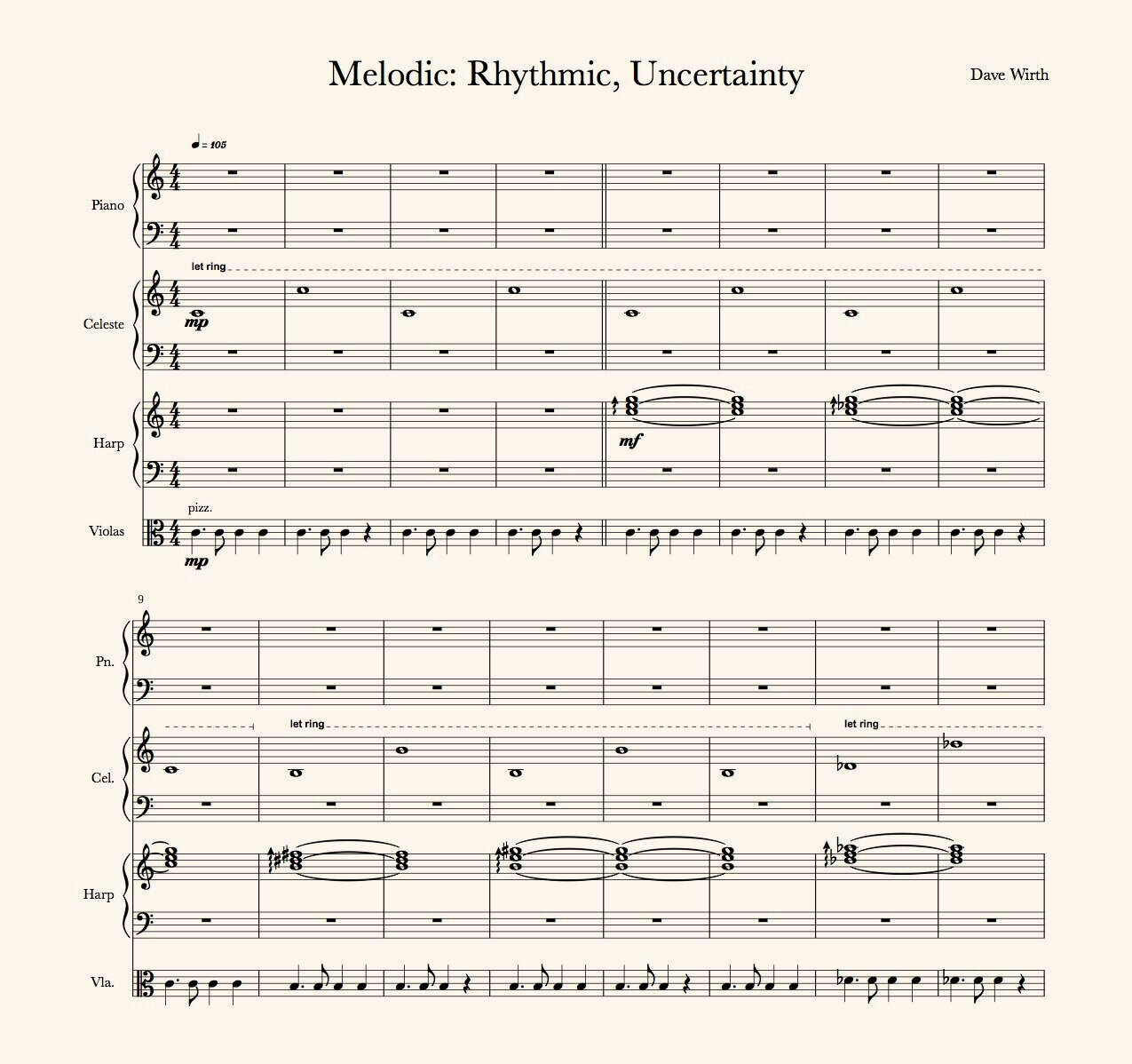
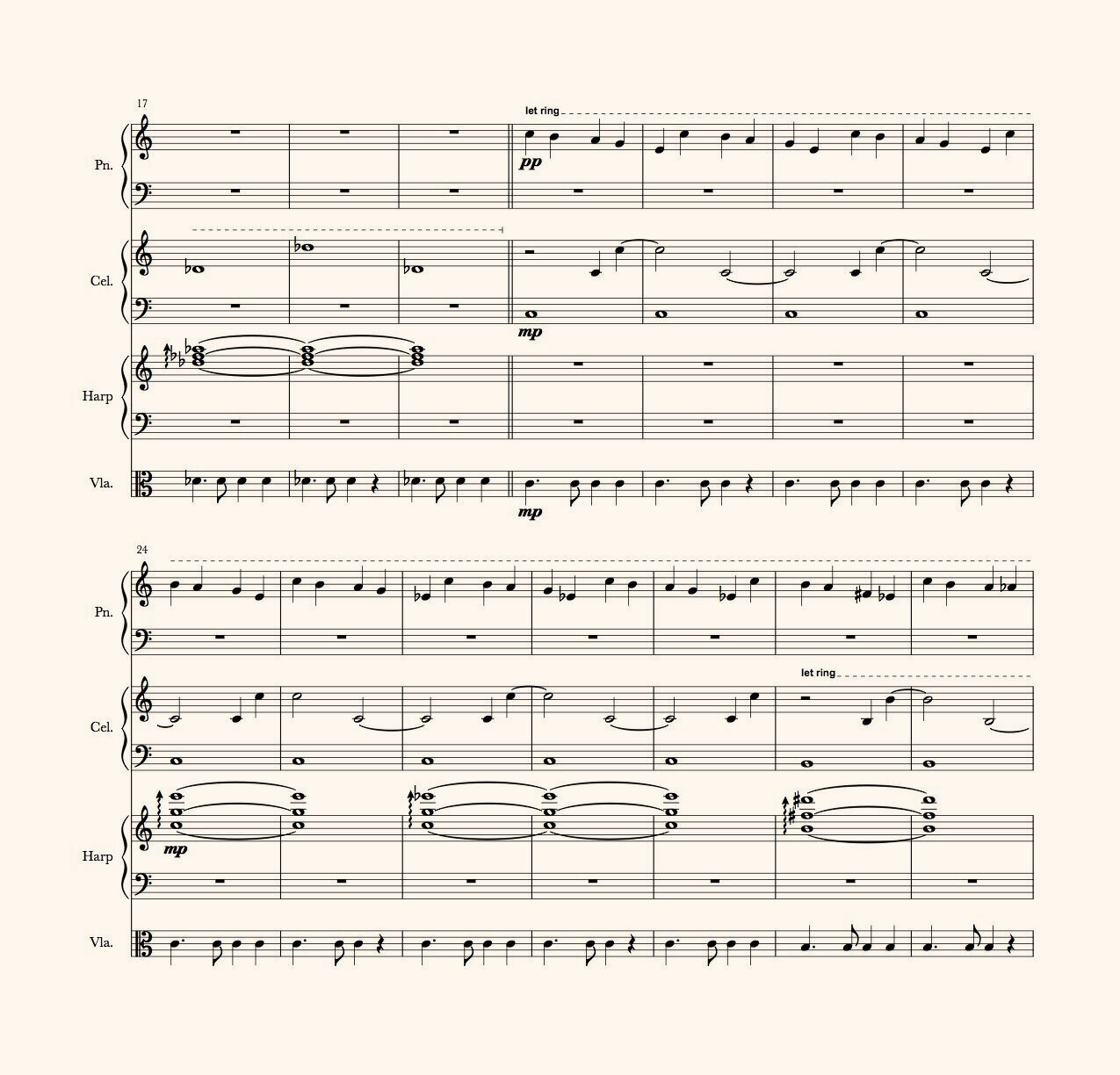
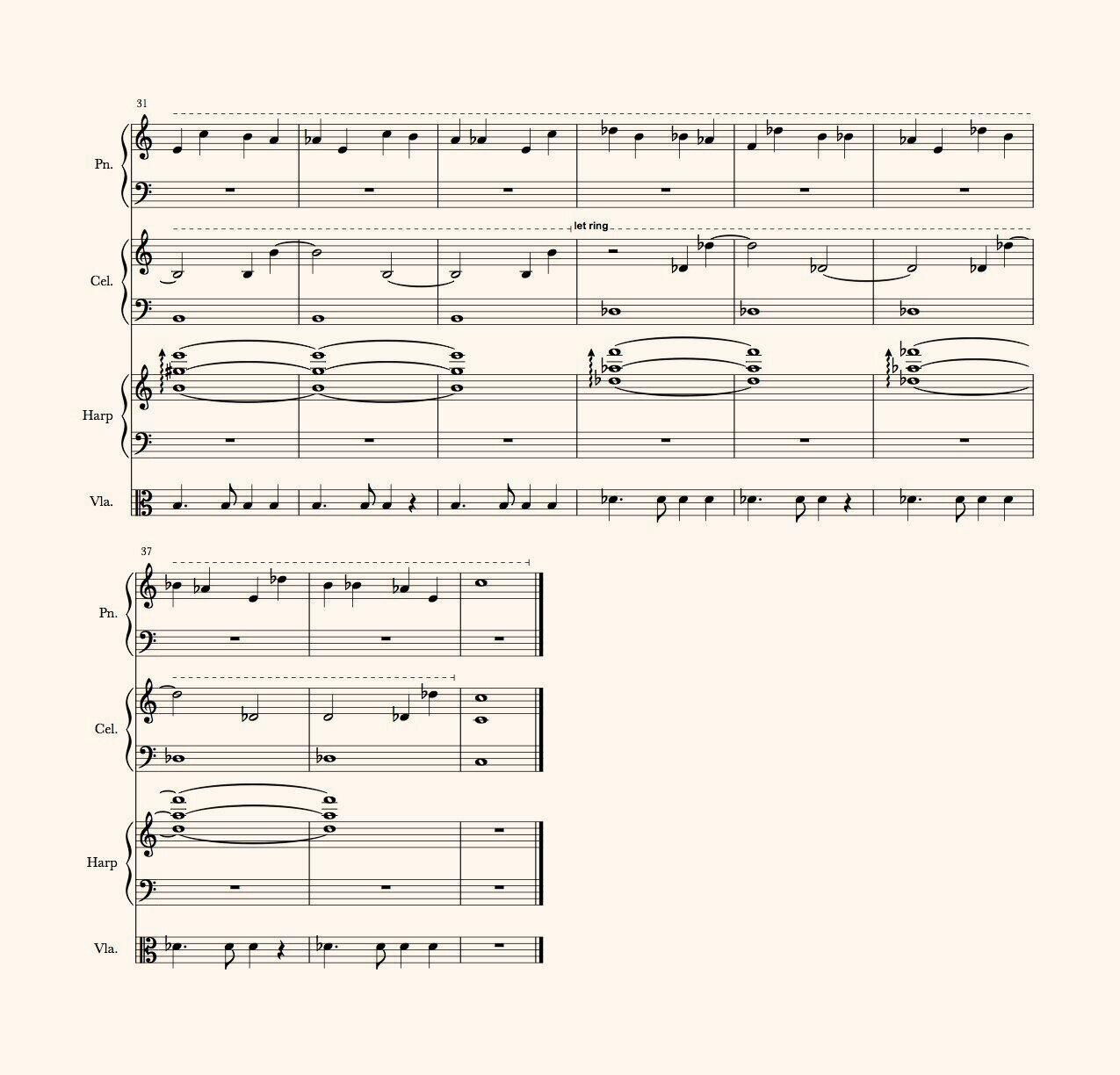
And finally, why can’t we make an incredibly gentle cue? The opposing melodies in the strings and the piano in the main theme sequence can be played in a totally different rhythm, and slower overall tempo. This would be ideal for the moment when we are going for something that is more intimate, a moment between two people, exchanging knowing looks with each other:
Composed by Dave Wirth, Copyright and Published 2019 Fire, Fire, Red Star Down! ASCAP. All Rights Reserved.
Flexibility in Melodically Themed Scores
Melodically themed film scores are classic, diverse, and incredibly flexible. They are a respectful nod to the golden age of cinema and can be appropriate for many styles of movies. They can be used to describe multiple moments in a film and unite it, either by using a single theme throughout or by using leitmotifs for every single action or character. Melodic themes can be used on a small-scale movie that’s set in one room, or they can be used on a film that’s set in multiple places in an unknown universe.
Melody is flexible.
But what if you want more subtlety, something a little less in-your-face, musically speaking? What if you dislike the idea of having a epically melodic score, like John Williams would write? What if you want something simpler? Easier? More relaxed? Slower moving? Subtle?
Musical Elementary Particle #2: Harmonic Themes
Sometimes in movies, you’ll hear music without there being a melody. In these movies, you could very well be hearing a harmonic theme. Harmonic themes are basically chord progressions: Two or more chords pressed together in linear time.
Chord progressions have an obvious advantage over melodies: They can easily stay out of the way of the action while still telling the story beyond the story.
Take the score for Moonlight by Nicholas Britell for example: A simple chord progression with a violin. It works brilliantly in this movie, perfectly appropriate for the pace. Another great chord progression that comes in a form of a theme is the opening chords for the Netflix series Sense 8. Those chords are the perfect start for this show. It’s memorable, it’s not hard to follow, and it described the show in less than 10 seconds.
Harmonic themes can be used to unite a movie in the same way that a melodic theme can. They can be used in different ways, orchestrated differently, and describe multiple moods. Also, they are fantastic for underscoring.
In this next main title sequence, I allowed myself only two instruments: A guitar and a piano. Let’s say that this was the first thing a viewer heard when they saw a movie:
Composed by Dave Wirth, Copyright and Published 2019 Fire, Fire, Red Star Down! ASCAP. All Rights Reserved.
Well, okay. We’ve got the chill and gentle and secret love vibe going. But what else can we do with it? Can I take what I’ve established and create a different vibe using only two instruments? Of course.
For this next example, I switched up the rhythmic duties to the guitar and make it sound more whimsical, but I kept the same chord progression.
Composed by Dave Wirth, Copyright and Published 2019 Fire, Fire, Red Star Down! ASCAP. All Rights Reserved.
Now if you are a musician and happened to play each of these parts on piano or guitar, you’d notice that I included a sneaky note that is always playing throughout all the chords, either by the piano or the guitar. It’s technically called a melodic pedal point, but you could think of it simply as a single note that is played throughout a progression, no matter what else is being played.
Why can’t I have the guitar play only that melodic pedal point, and have the piano play related chords in a similar chord progression? The result is that it feels a bit unstable and uncertain, perfect for a point of indecision in a film:
Composed by Dave Wirth, Copyright and Published 2019 Fire, Fire, Red Star Down! ASCAP. All Rights Reserved.
And finally, if we wanted to have a cue that was extremely gentle, we can use the guitar for something it’s uniquely qualified for: Fingerpicking. Fingerpicking has always had a gentle feeling associated with it. To achieve this, the guitar plays a simple fingerpicking pattern while the piano plays in a gentle way, lightly accenting the music. It’s even more intimate, cozy even, than the others:
Composed by Dave Wirth, Copyright and Published 2019 Fire, Fire, Red Star Down! ASCAP. All Rights Reserved.
Harmonic themes offer a different approach. If you prefer subtlety, if you don’t want the music to swiftly take the viewer on a big emotional journey, a harmonically themed score might be just the ticket. It works marvelously in movies where the pace is slower, the editing is slower, and the audience has time to absorb nuance.
But is that all there is? What if you don't want the grandiosity of a melodically themed score, nor the subtlety of a harmonically themed score? What if you want something more experiential, something more immersive, something that could be downright frightening in some aspects?
Enter textural themes.
Musical Elementary Particle #3: Textural Themes
One of my favorite film composer teams is Ben Salisbury and Geoff Barrow, widely known for their synthesizer-based scores. Though they still make use of melodic and harmonic themes, I highly enjoy listening to their use of analog synths to create an ambient musical immersion into the world of the story they are composing for.
Take Ex Machina for example. Yes, there is a melodic theme in the movie, but at the same time there is a bounty of ambient electronics throughout. Another wonderful score from this composer team is Annihilation. The electronics they used perfectly captured the Shimmer, an expanding void that annihilates and changes everything in the story of the movie. It is a brilliant score. Whenever I listen to it, I am instantly transported inside the film.
Texture can be used to create a sense of space in a movie, one that can be immersive without being overwhelming, one that can bring the listener deeply into a state of being without telling them what to feel.
Cigar Box Noisemaker by AMBO Art
To achieve a unified sound, I decided to use a guitar that my good friend WT from AMBO Art created for me recently: A cigar box guitar that was meant to create strange sounds. I decided to use this instrument and a couple of digital synthesizers to create a landscape we could enter and feel like we were a part of. My intent was to create an immersion into a world that felt deathly and grim:
Since I established that this is a more textural theme, and since I established that sound of the bowed cigar box, why can’t I use it in a more apprehensive, almost combative way?
Similarly, I decided to make the next one be incredibly rhythmic, something weirdly galvanizing, something not totally of this world. It reminded me of a deathly march:
And then, we need our “story” to resolve, right? Well, that challenged me because well, how do I make something like this actually sound more gentle? Or at least as gentle as it can be made?
Here’s what happened:
And just like that, a unified textural theme.
Finding the Best Possible Musical Theme For A Film
Finally we have arrived to the real question: How do you decide what type of elementary particle, what kind of theme is best for your movie's score?
Let’s start with the fact that your movie is unique. It’s very possible that a mixture of each of these elementary particles, or even ones I didn’t present in this post, could be the best way forward. And maybe you, as the director, don’t even need to know this for certain. The only thing we’re all sure of is that the score must enhance the film. It must be appropriate for your movie and support the story.
The best part of working with a composer is that we can help you find and structure the musical representation of the story. We really care about music, and we want to make sure your movie is enhanced with our efforts.
For us composers to understand your movie truly, we have to feel it. We have to know it as well as you do. To be totally clear: We don’t often need you to be able to say exactly what orchestration or compositional technique or chord progression or melodic technique is needed, but what we do need is your view of the film and the story.
To get there, try to be open about what your movie is about, it's theme, it's essentials. Talk about everything with the story, the world the story lives in. Talk about the color, the cinematography, the acting, the editing, and the sound of the production. Talk about how it was filmed, where it was filmed, why it was filmed the way it was filmed, and what you were working to accomplish. The composer will pick up ideas naturally from this discussion. She will figure out an appropriate way forward if you’re willing to talk about your story and your expectations. In short, you’re priming the composer to understand your film before she goes about writing for it.
Once we composers have some clarity about the world you’ve created and the type of score you want, we have to willingly enter the liminal space for ideas. We pay the prices of confusion and indecision. And quite possibly, we might have a brilliant idea hit us that is perfect for the movie on the first try.
If it were me creating your score, the only ideas I would present to you would be the ones that I think would encapsulate and serve the film. For me, the theme must be special, possibly special enough to be remembered, but not so special that it overtakes the movie and the story you’re presenting.
And then, the collaboration continues. I always ask for the director’s feedback on any potential direction because it saves time and frustration on both sides. I’ll send some sketches. I’ll send some rendered videos of the elementary particle in action. I’ll send a quick sample that gives a faint idea of a possible direction. If a director doesn’t like it, then the conversation starts anew, this time with more clarity. I actually love it when I miss the mark because it means I have a clearer direction!
Again, I’ll enter the liminal space, I pay close attention to distant thunderstorms of ideas, I create some sketches. And eventually, I’ll find the right foundation for the score that the director loves. It’s a simple process of elimination.
Once the director and I are united as far as the direction, then comes the fun part: Scoring for the scenes. I’ll use the elementary particles that I’ve established that the director likes, and I’ll create the first scene. Then keep going.
My aim at this point is to build on the ideas with the chosen elementary particles until the score helps the movie become a living beast. I want that movie to become something that looks back at the audience.
The Building Blocks and Elementary Particles of Story
There are trillions of ways of creating a solid, unified score, and they are as varied as the amount of composers actively composing.
You may already have a script that is totally banging… just brimming with that creative energy. Taking time to work with a composer on the most appropriate film score could bring your movie to the toppermost of the poppermost, to quote John Lennon.
Finding the exact right kind of score, one with the correct audio perspective, orchestration, or any sort of elementary particle, can be tough. I’m not afraid to enter the liminal space to get there because I know the embarrassment of riches, the spoils of that in-between space.
Sooner or later, the right elementary particle comes along that can help unify a story completely.
Just like walking was the elementary particle that allowed you to feel how I felt as a junior high schooler desperate to be popular without spelling it out for you, unifying a movie through multiple motifs can create a wonderful experience for a theater-goer. An appropriate soundtrack can aid you in your quest to create a movie that looks back at you when you’re finished.
And lemme tell you: The audience loves a beast.
Please, leave me a comment!
Or, feel free to reach out to me.
More Articles on Film and Music
Copyright Notices
All music that appears on this article was composed by Dave Wirth, Copyright and Published 2019 Fire, Fire, Red Star Down! ASCAP. All Rights Reserved.
Public performance of the music without written permission is strictly prohibited.






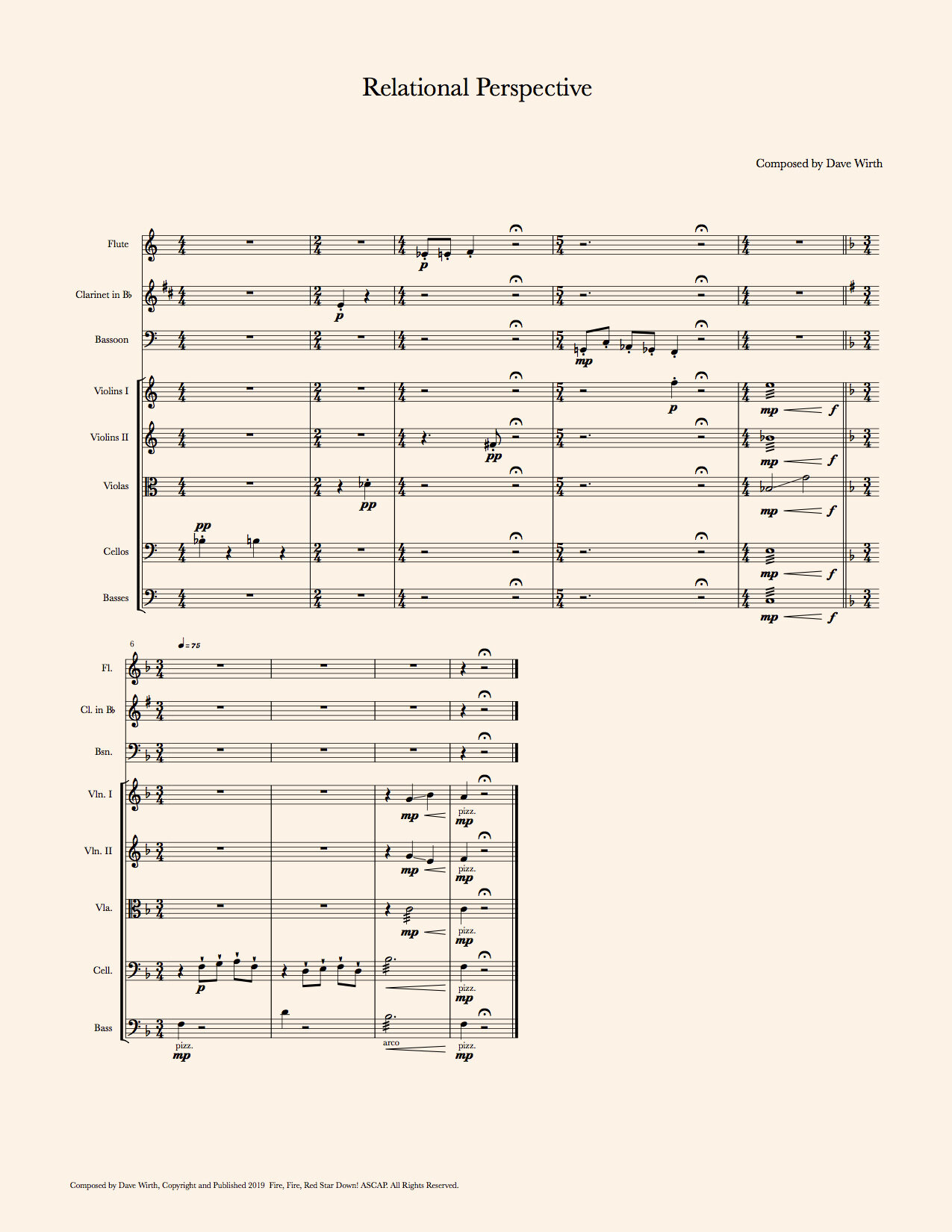
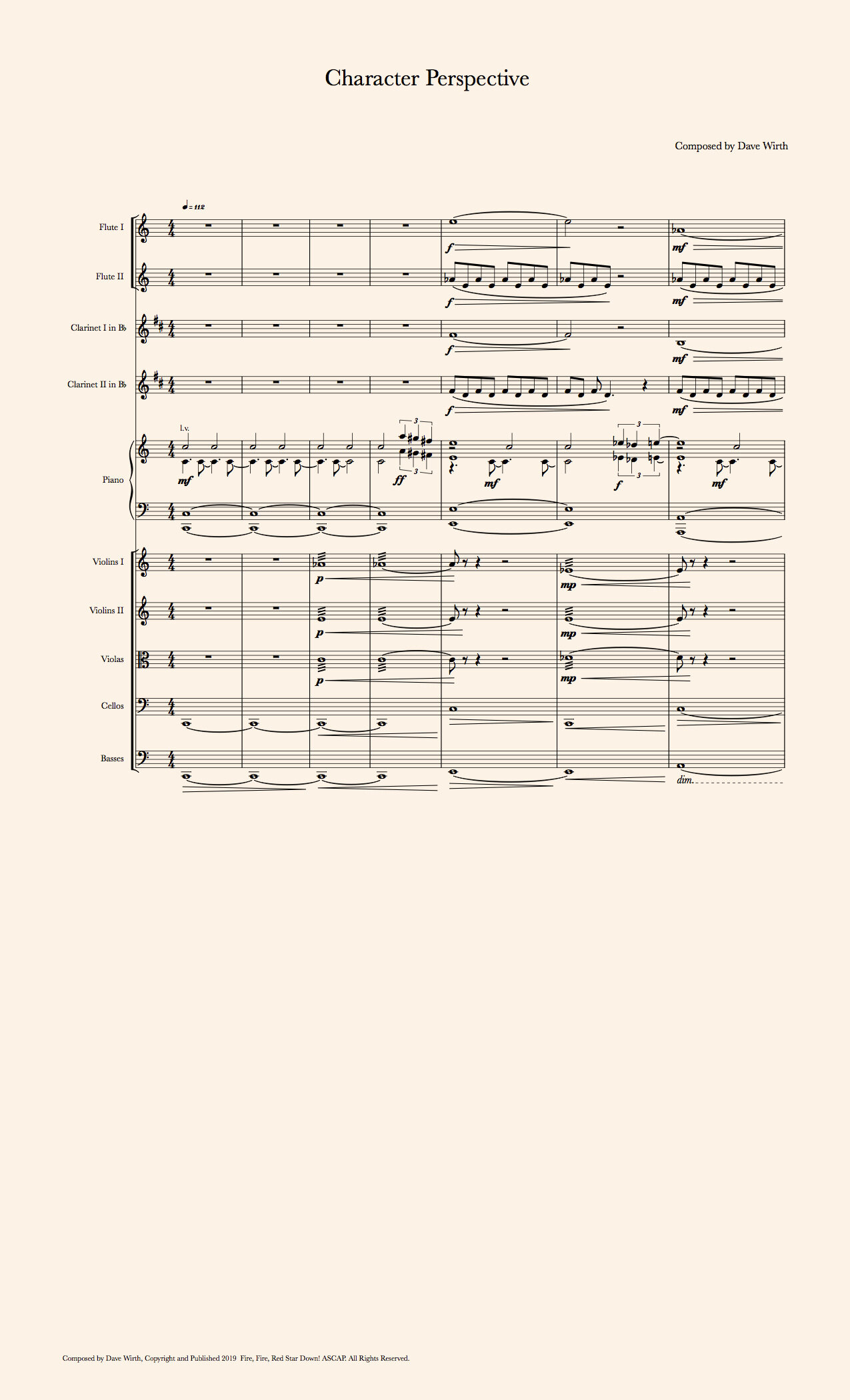
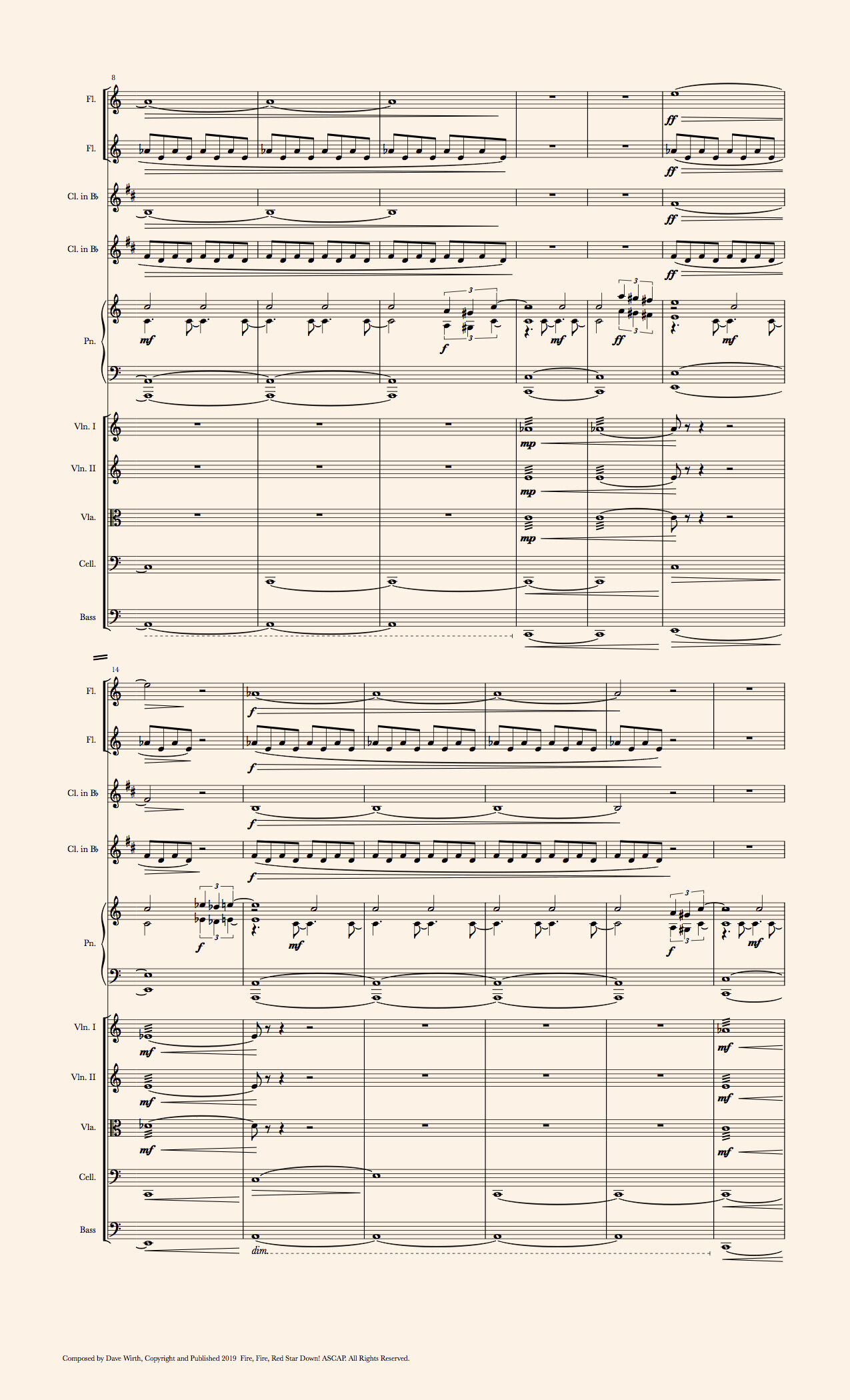
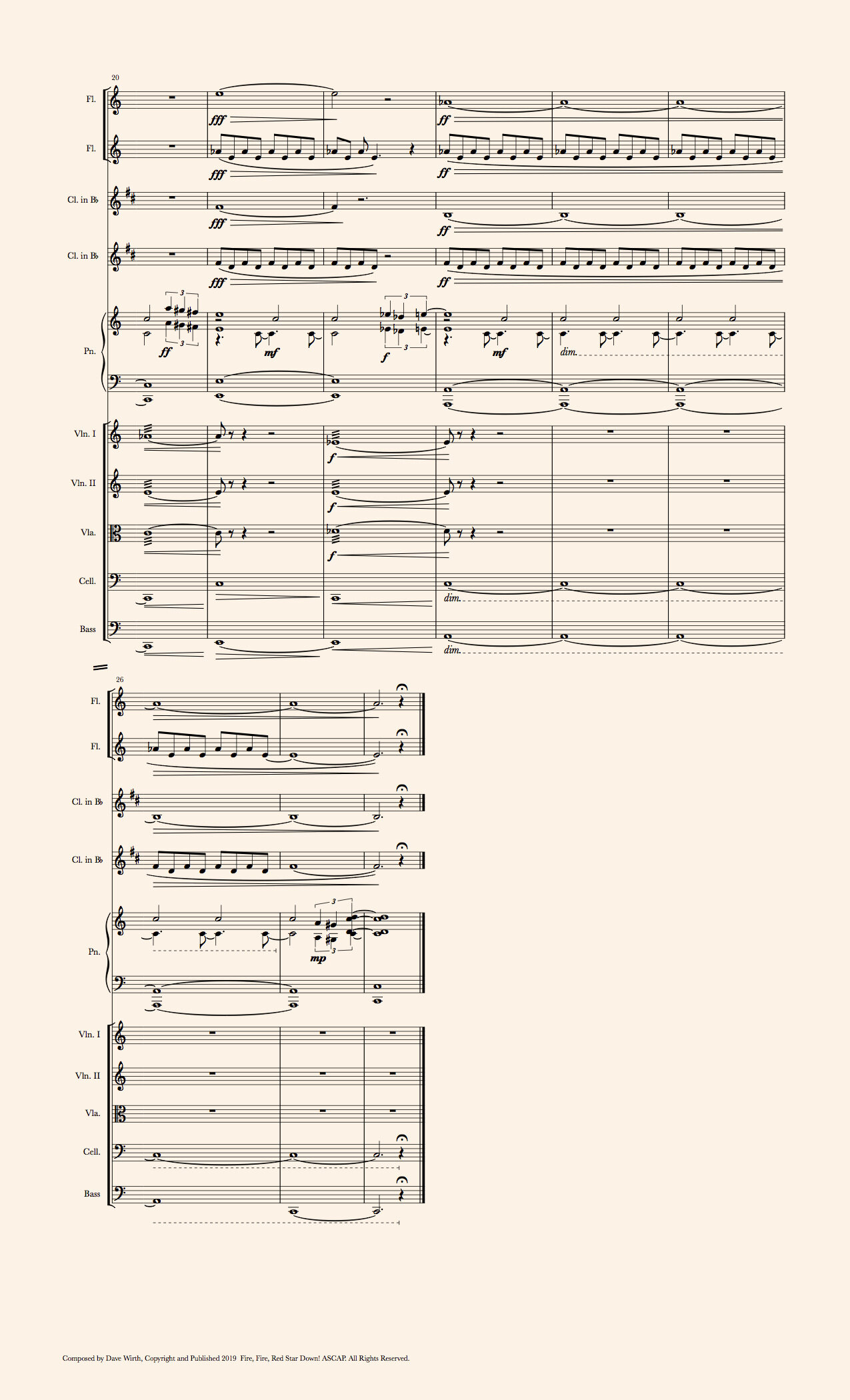



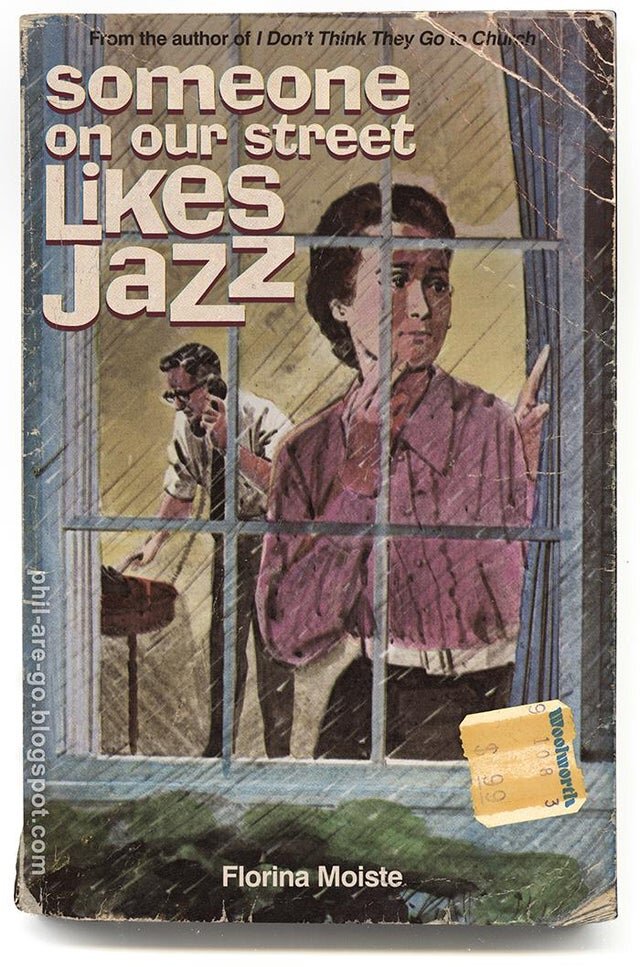














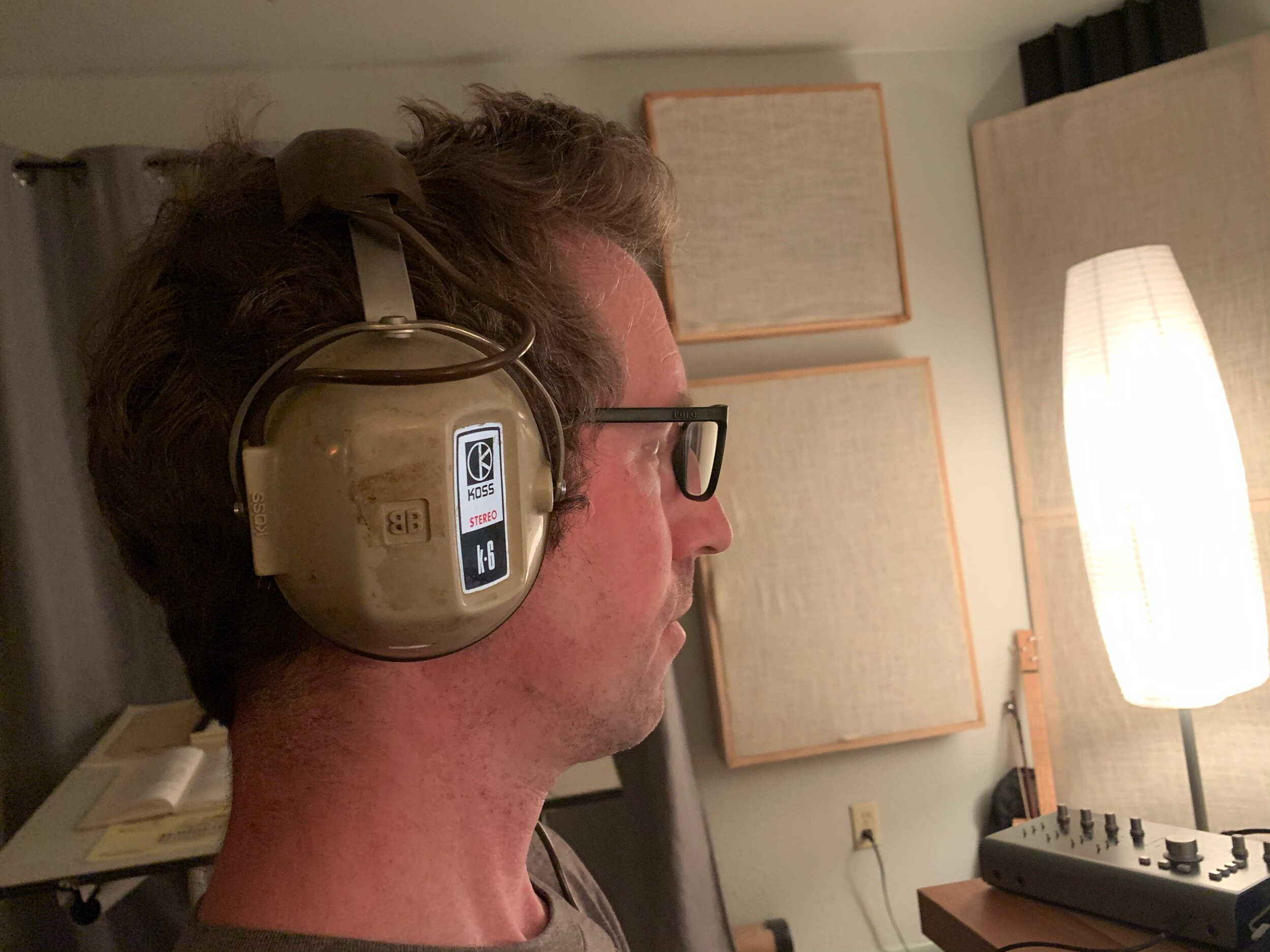








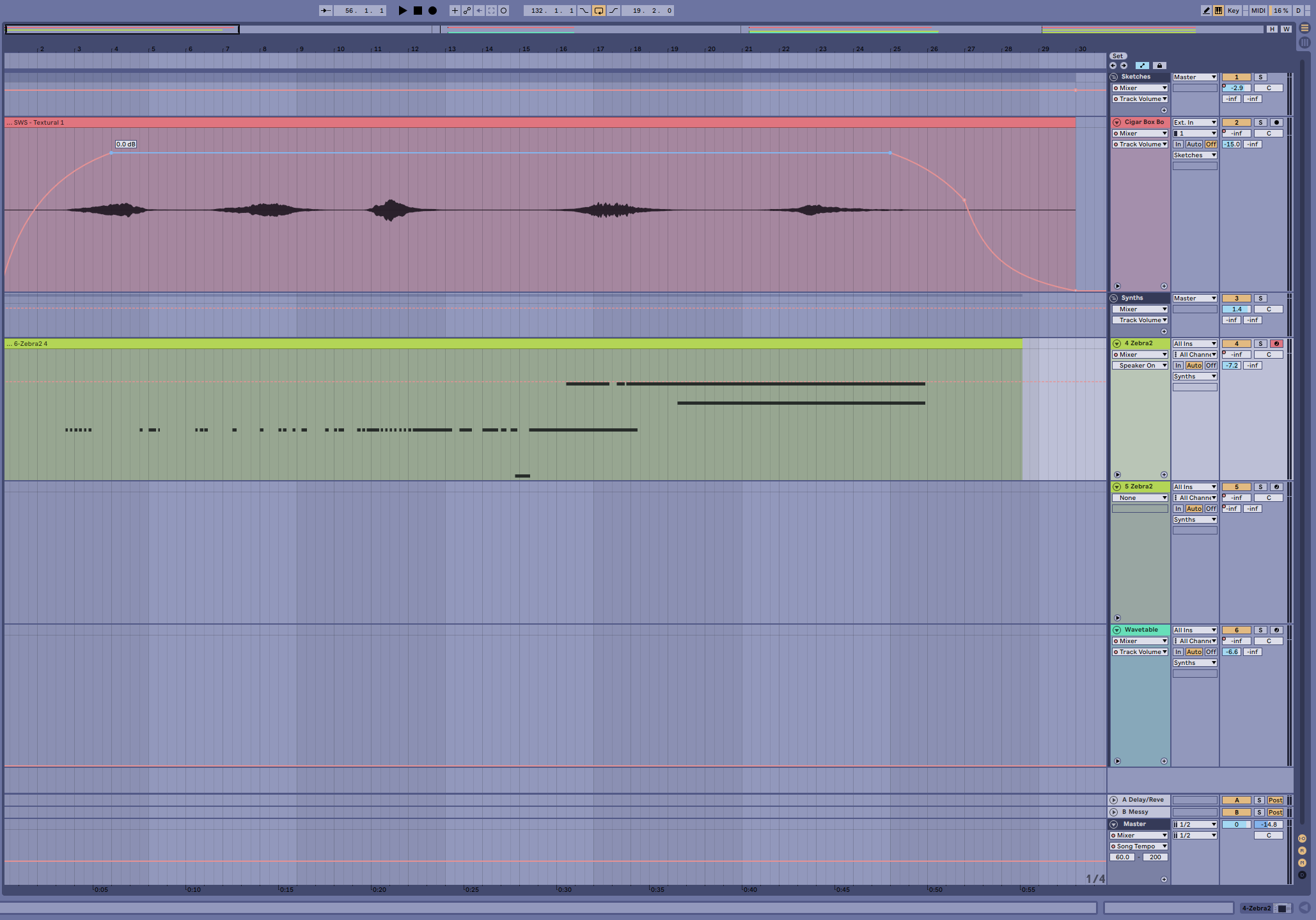



The music on your film is a powerful tool to deliver fresh perspectives, and believe me: Fresh perspectives are vital. This article goes deep into Audio Perspective, i.e. the music being written from the most compelling perspective in the story. Mastering audio perspective can make your movies far more relevant, relatable, and successful.
If you’ve ever wondered how you can use music to communicate a compelling perspective, this article is for you. Let’s hit it!